Singapore is home to a rich and diverse population of bird species. From the colourful parrots of Jurong Bird Park to the migratory seabirds of Pulau Ubin, Singapore’s birdlife is an important part of the country’s natural heritage.
This diverse selection of avian species provides an opportunity to observe some of the most beautiful and fascinating birds in the world. Whether you’re a dedicated birdwatcher or simply out for a leisurely walk, Singapore’s birds are sure to bring plenty of wonder and delight.
1. Black-Naped Oriole
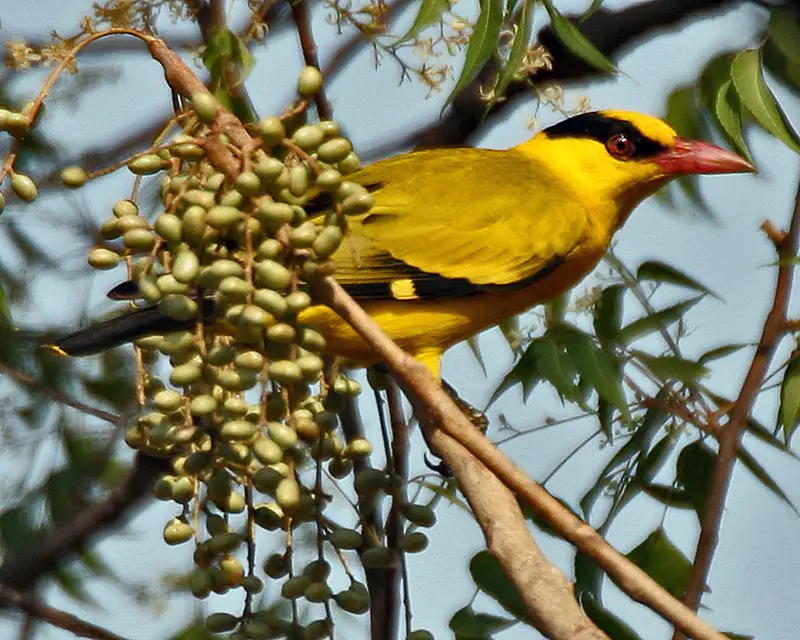
The Black-naped Oriole is a stunning bird native to Asia. It has bright yellow feathers with black markings on its head, wings and tail. Its beak and legs are also black in colour.
These birds can grow up to 25 cm long and they have very distinctive eye stripes – the eye stripe of this species is broader than that of the Indian Golden Oriole.
They mostly inhabit forests as well as open areas such as grasslands, orchards and gardens where there are plenty of trees for them to feed on insects or fruits like figs, dates and berries.
The Black-naped Orioles live in small flocks during their nonbreeding season but become solitary when breeding begins which usually occurs between March and May each year depending upon location.
Scientific classification:
| Kingdom | Animalia |
| Phylum | Chordata |
| Class | Aves |
| Order | Passeriformes |
| Family | Oriolidae |
| Genus | Oriolus |
| Species | O. chinensis |
2. Rock Dove
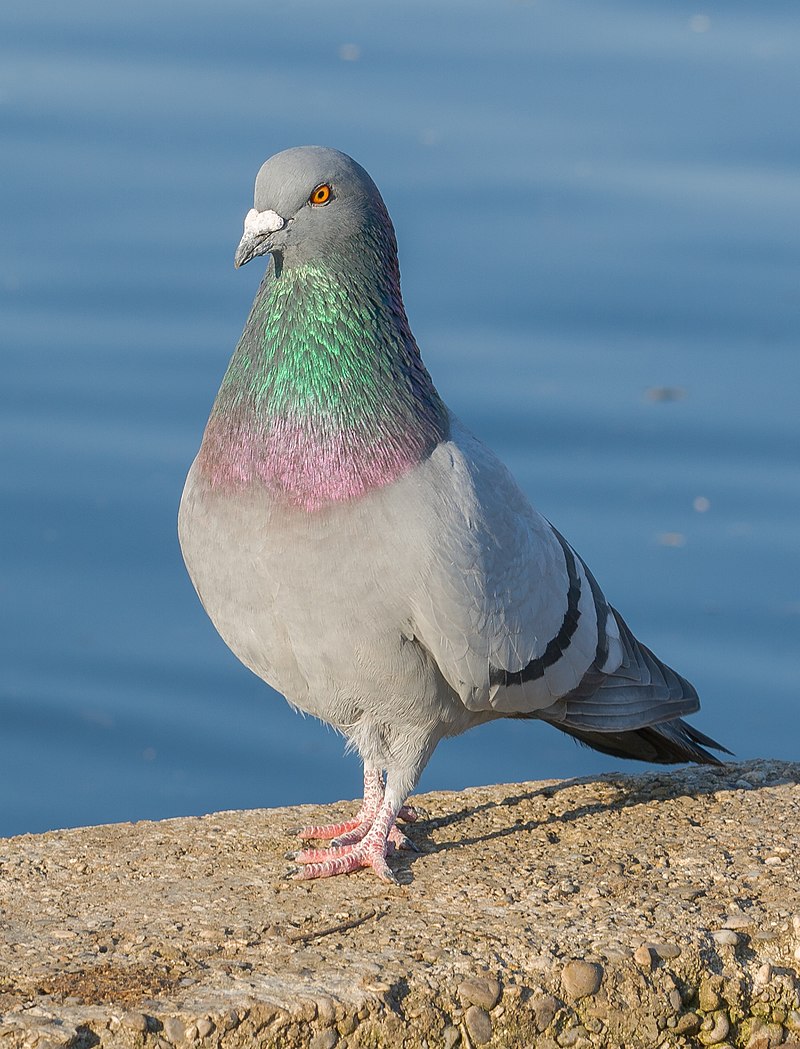
Rock dove, also known as Rock Pigeon or Common Pigeon, is a member of the bird family Columbidae.
It is considered to be an important creature worldwide due to its domestication by humans centuries ago; resulting in the modern-day Domestic pigeon which descends from this species.
Its population has increased over time because some domestic pigeons have escaped captivity and joined wild populations.
The rock dove can most easily be identified by its prominent blue-grey feathers with darker bars on wings and tail along with two black bands on each wing.
They are typically found in large flocks near cliffs or buildings but may also inhabit rural habitats such as open fields and meadows if there’s enough food available for them nearby.
Although they don’t migrate far distances like other birds, their numbers increase significantly during winter months.
When more food sources become available closeby so that they won’t need to travel too far away from home base for nourishment.
Scientific classification:
| Kingdom | Animalia |
| Phylum | Chordata |
| Class | Aves |
| Order | Columbiformes |
| Family | Columbidae |
| Genus | Columba |
| Species | C. livia |
3. King Quail
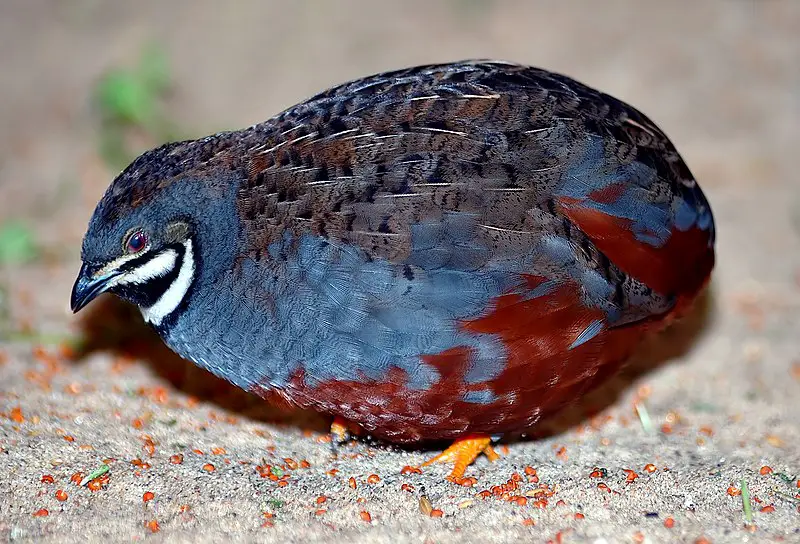
The King Quail is a species of Old World quail found in Southern China, South and Southeastern Asia to Oceania. It’s the smallest “true quail” measuring only about 17 cm long.
They have grey-brown feathers on their back and wings with black barring over white underparts that can be seen from above.
The head has blue cheeks, a bright red forehead patch, and tufts of brownish-black feathers along the top while its throat is bordered by buffy yellow stripes down each side.
In addition males are also easily identified by their striking bluish plumage around the neck which gives them their common name ‘the Blue Breasted Quail’.
Despite an attempt to introduce this bird into North America they remain confined mostly to Australia where they inhabit grasslands, wooded areas near watercourses or swamps as well as open forest habitats but rarely exceed 100 meters altitude in range
Scientific classification:
| Kingdom | Animalia |
| Phylum | Chordata |
| Class | Aves |
| Order | Galliformes |
| Family | Phasianidae |
| Genus | Synoicus |
| Species | S. chinensis |
Also Featured In: Aviary Birds You Should Know, Samar Island Birds You Should Know
4. Sunda Pygmy Woodpecker
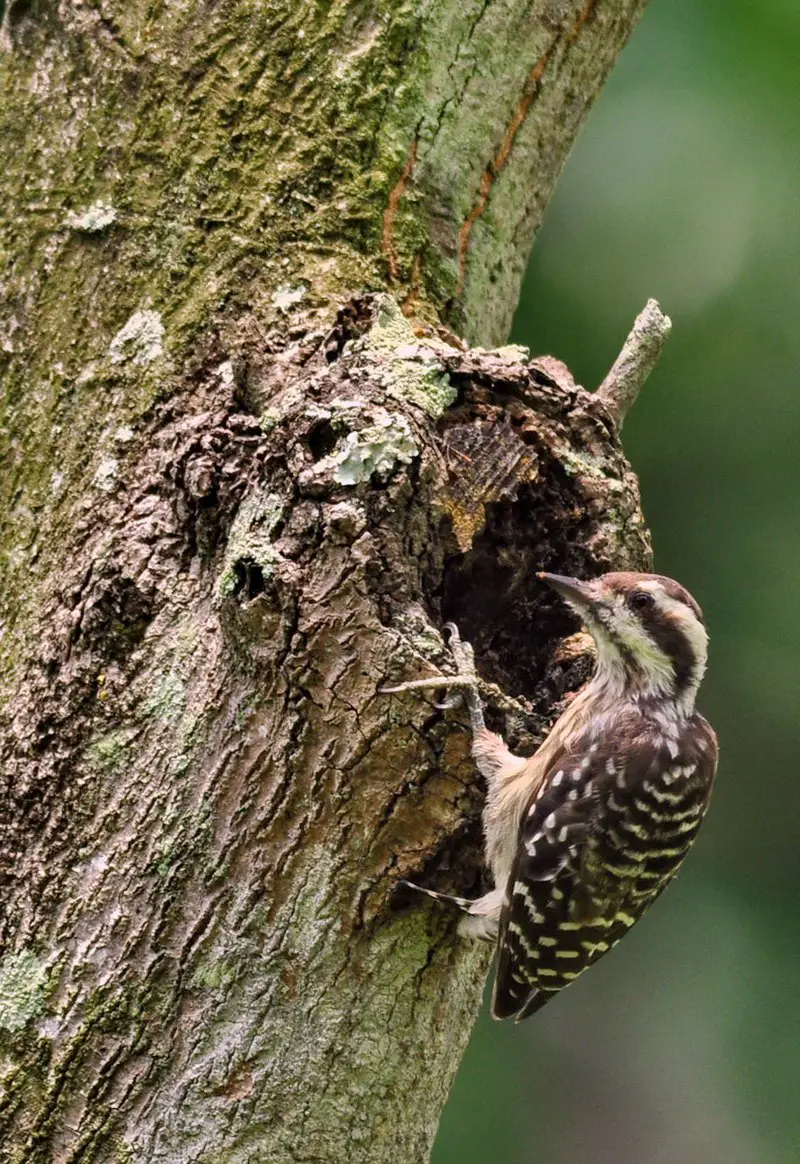
The Sunda Pygmy Woodpecker is a species of bird that can be found in Brunei, Indonesia, Malaysia and Singapore.
It has an average size range of 11.5-12.5 cm and its head is greyish brown with dark brown ear covers which contrast nicely against its light coloured body.
Its wings are long with white spots on them while the tail feathers have yellow tips to them giving it a unique look when seen up close or from afar.
This woodpecker mainly feeds on insects but will also eat small fruits if they come across any during their travels throughout the dense forests they inhabit.
They make their nests high up in trees where they stay safe from predators and other dangers posed by living near open land such as humans or animals who may threaten them for food sources or shelter locations should the need arise.
Scientific classification:
| Kingdom | Animalia |
| Phylum | Chordata |
| Class | Aves |
| Order | Piciformes |
| Family | Picidae |
| Genus | Yungipicus |
| Species | Y. moluccensis |
Also Featured In: HDB Approved by Birds,
5. Pink-Necked Green Pigeon
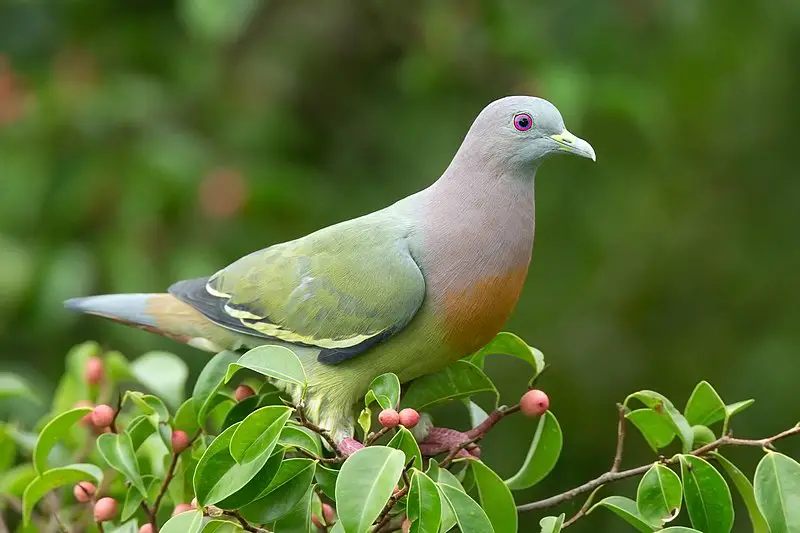
The Pink-necked green pigeon is a beautiful bird of the Columbidae family, native to Southeast Asia. Its body is mainly covered with emerald feathers and only the male has an eye-catching pink neck.
It can be found from Myanmar and Vietnam down to Indonesia and even in parts of Philippines, where it’s known as “punay”.
This medium sized species loves feeding on fruits such as figs or guavas but also enjoys snacking on insects from time to time.
In its natural habitat, this colorful avian often nests high up in trees for better protection against predators.
All in all, the unique beauty of Pink-necked Green Pigeon makes it one truly remarkable bird.
Scientific classification:
| Kingdom | Animalia |
| Phylum | Chordata |
| Class | Aves |
| Order | Columbiformes |
| Family | Columbidae |
| Genus | Treron |
| Species | T. vernans |
6. Asian Koel
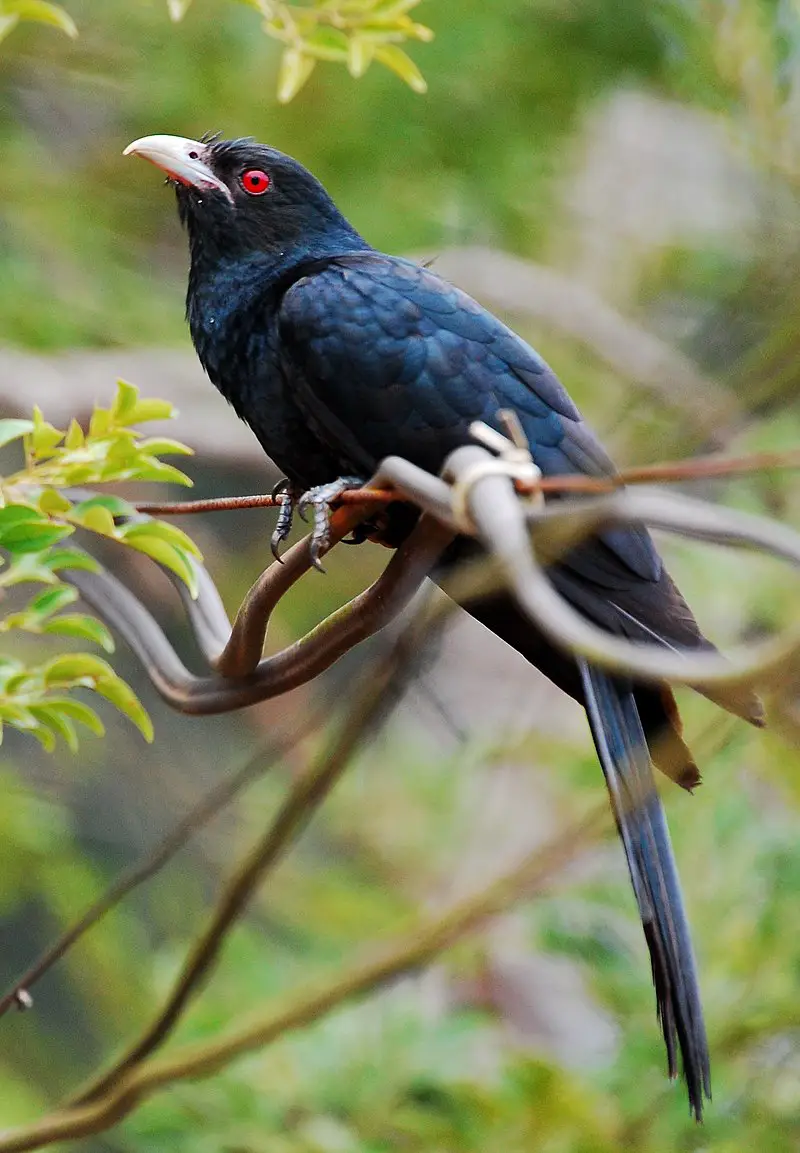
The Asian koel is a member of the Cuculiformes family, found in India, China and Southeast Asia. It shares its range with two closely related species – black-billed koels and Pacific koels.
This bird exhibits brood parasitism; it lays its eggs in nests of other birds, who then unknowingly become foster parents to their young.
Characterised by long tails and glossy feathers that vary from deep blue to greenish-black depending on region, these birds are known for their loud call which can be heard during both day or night time.
They feed mainly on fruits but also take insects when available.
All in all, the Asian Koel is an interesting species that has adapted itself well over many centuries within different ecosystems across Asia.
Scientific classification:
| Kingdom | Animalia |
| Phylum | Chordata |
| Class | Aves |
| Order | Cuculiformes |
| Family | Cuculidae |
| Genus | Eudynamys |
| Species | E. scolopaceus |
7. Coppersmith Barbet
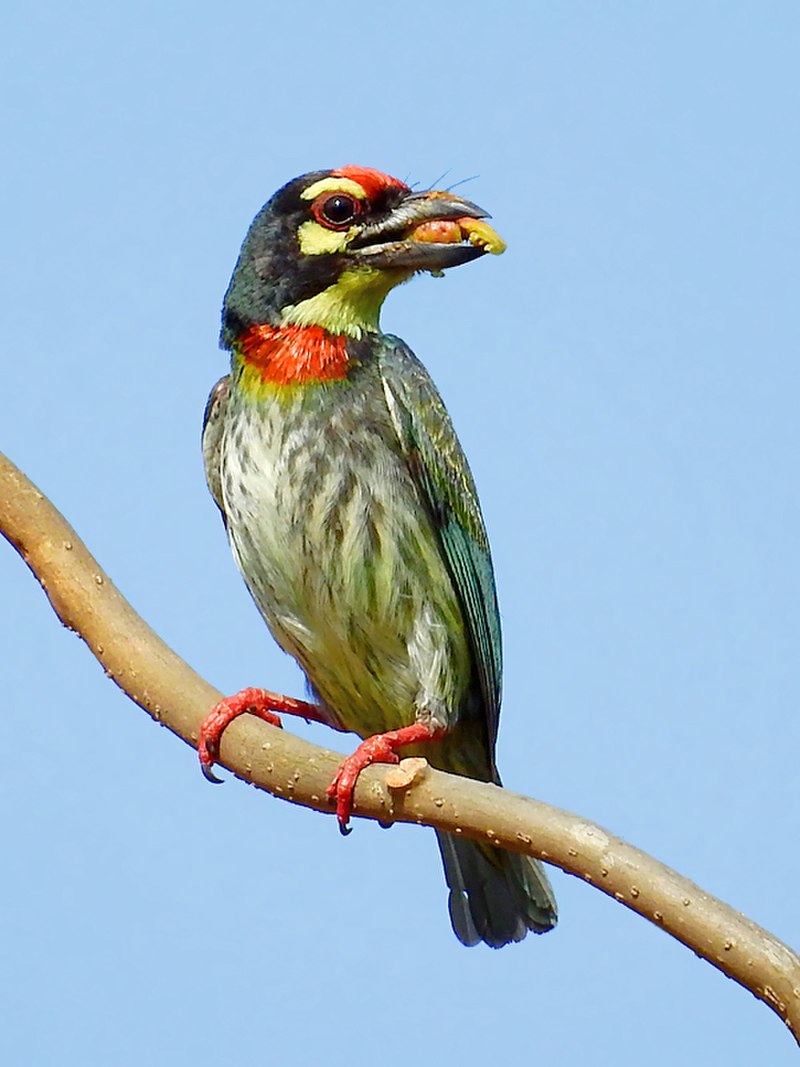
The Coppersmith barbet is an attractive Asian bird, easily recognizable by its bright crimson forehead and throat.
It has a call that sounds like a coppersmith striking metal with a hammer – hence its name.
These birds are found in the Indian subcontinent and parts of Southeast Asia where they build their nests inside trees, carving out holes for themselves.
They can often be seen perched high up on trees or wires during the day as they feed on fruit from nearby branches.
The vibrant colors of these birds make them stand out amongst other species in their habitat.
Scientific classification:
| Kingdom | Animalia |
| Phylum | Chordata |
| Class | Aves |
| Order | Piciformes |
| Family | Megalaimidae |
| Genus | Psilopogon |
| Species | P. haemacephalus |
8. Old World Flycatchers
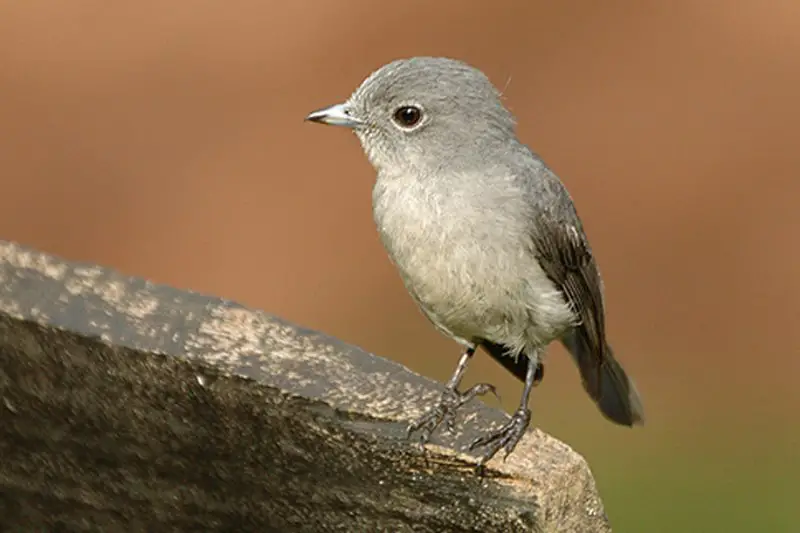
The Old World Flycatcher is a family of small passerine birds, native to Europe, Africa and Asia. They are mainly insectivorous arboreal birds that feed on insects they catch in the air or trees.
Their wingspan ranges from 5-11 inches long with males usually being slightly larger than females.
The coloration of these birds can range greatly depending on species but typically have dull greyish brown upperparts and pale undersides which help them blend into their environment for hunting purposes.
Bluethroat (Luscinia svecica) and Northern Wheatear (Oenanthe oenanthe) are two exceptions as they can be found in North America too.
These charming little creatures make fun additions to birdwatching lists all over the world because of their vibrant colors and interesting behaviors.
Scientific classification:
| Kingdom | Animalia |
| Phylum | Chordata |
| Class | Aves |
| Order | Passeriformes |
| Superfamily | Muscicapoidea |
| Family | Muscicapidae Fleming J., 1822 |
9. Asian Glossy Starling
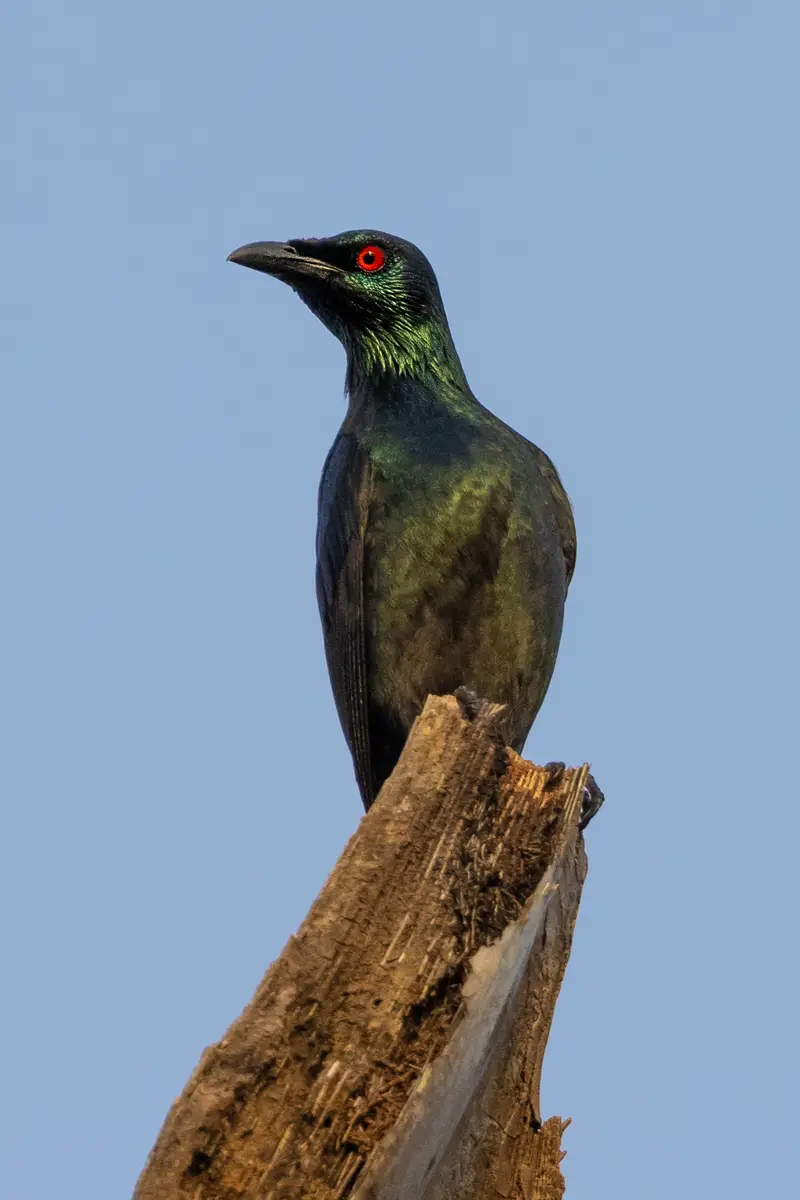
The Asian glossy starling is a small bird with a beautiful iridescent plumage. It has black feathers on its head, neck and wings that have an intense blue-green sheen in the sunlight.
Its tail feathers are tipped white and it also sports yellow legs and feet. The female of this species differs from the male by having duller colors overall as well as paler underparts than the males do.
This species can be found throughout parts of Bangladesh, India, Indonesia, Malaysia Myanmar Philippines Singapore Taiwan (introduced)and Thailand living mainly in subtropical or tropical moist lowland forest habitats but they can also be spotted inhabiting mangrove forests too.
They feed mostly on insects such as grasshoppers which they catch while flying through their natural environment but will sometimes eat fruits when available to them too.
Scientific classification:
| Kingdom | Animalia |
| Phylum | Chordata |
| Class | Aves |
| Order | Passeriformes |
| Family | Sturnidae |
| Genus | Aplonis |
| Species | A. panayensis |
10. Spotted Dove
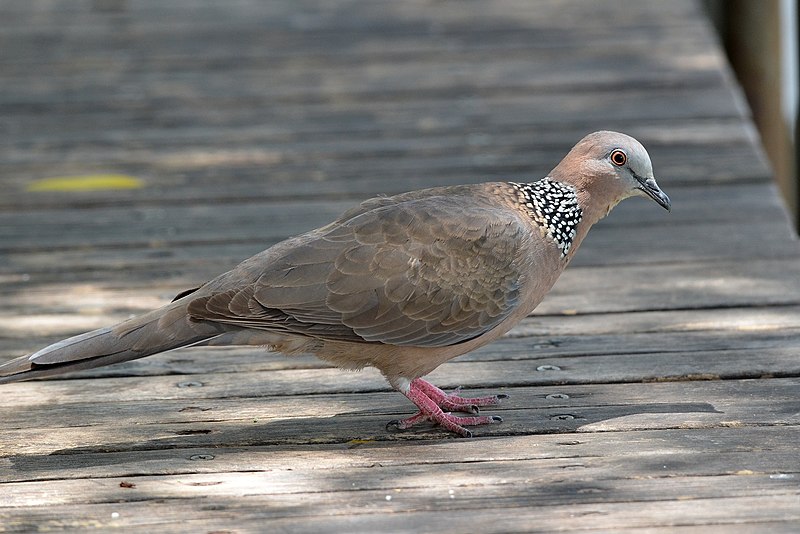
The Spotted Dove is a common species of pigeon found in the Indian subcontinent and Southeast Asia. It has an elegant, slender body with small head, long tail feathers and spotted wings.
Its coloring ranges from grey to brownish-grey on its upperparts with white underparts that are speckled black or dark grey. The male generally has more prominent spots than the female.
They feed mainly on seeds but will also consume insects when available during breeding season as well as berries, grains and fruits throughout their range.
These birds typically live in pairs or small groups near water sources such as ponds, rivers or streams where they can find food easily while staying safe from predators like cats and hawks.
Scientific classification:
| Kingdom | Animalia |
| Phylum | Chordata |
| Class | Aves |
| Order | Columbiformes |
| Family | Columbidae |
| Genus | Spilopelia |
| Species | S. chinensis |
11. Slaty-Breasted Rail
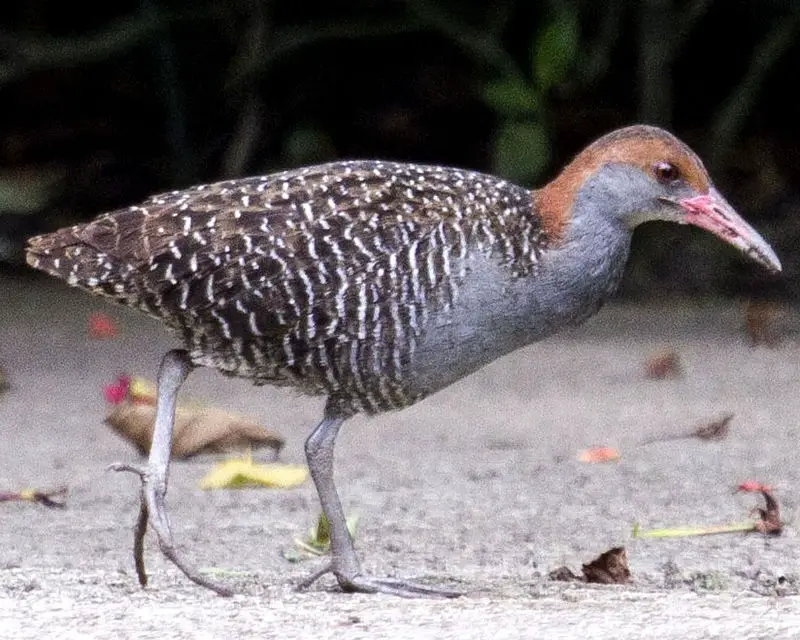
The Slaty-breasted Rail is a bird native to the Indian Subcontinent and Southeast Asia. During breeding season, they can be found near Dehradun in the foothills of India’s Himalayas.
This species has been placed in its own genus Lewinia due to new genetic studies which have now been accepted by the IUCN.
The plumage of this rail consists mainly of slaty grey with some black barring on its wings and tail feathers as well as vibrant chestnut flanks and belly.
It prefers habitats such as wetlands, muddy tidal flats or open grasslands for foraging where it searches for worms, insects and crustaceans among vegetation or mudflats respectively.
Despite being uncommon throughout much of their range these birds are not yet considered threatened – though further research into population numbers is necessary before we can fully understand their conservation status today.
Scientific classification:
| Kingdom | Animalia |
| Phylum | Chordata |
| Class | Aves |
| Order | Gruiformes |
| Family | Rallidae |
| Genus | Lewinia |
| Species | L. striata |
Also Featured In: Birds that Live in Kuala Lumpur, Common Birds of Maharashtra
12. Blue-Eared Kingfisher
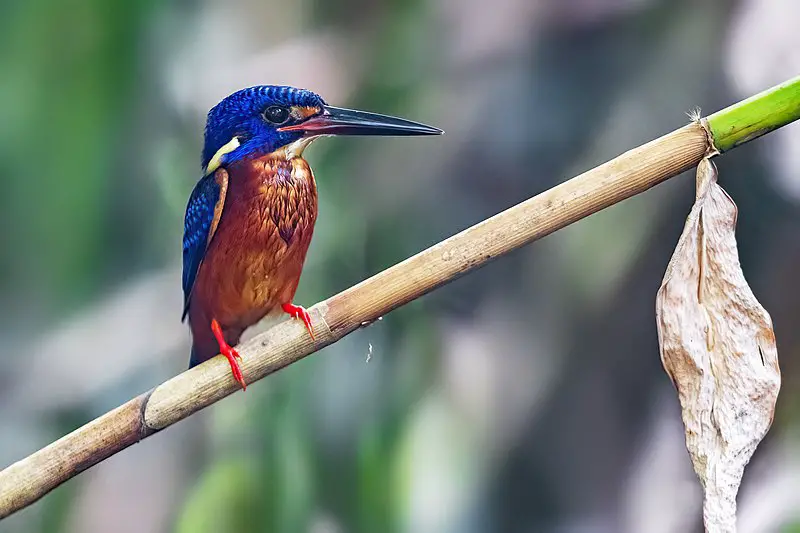
The Blue-eared Kingfisher is a beautiful species of bird found mainly in the dense forests across India and Southeast Asia.
Its distinguishing features include its darker crown, dark rufous underparts, and lack of the typical red ear stripe seen on other kingfishers such as Alcedo atthis which usually inhabit more open environments.
There are different subspecies identified by researchers due to slight variations in size or colouration present within this species.
The Blue-eared Kingfisher feeds mostly on small fish it catches while hunting along slow moving streams near shaded areas that provide plenty of cover from predators.
Not much else is known about these beautiful birds but they remain an important part of their local ecosystems.
Scientific classification:
| Kingdom | Animalia |
| Phylum | Chordata |
| Class | Aves |
| Order | Coraciiformes |
| Family | Alcedinidae |
| Subfamily | Alcedininae |
| Genus | Alcedo |
| Species | A. meninting |
13. Blue-Throated Bee-Eater
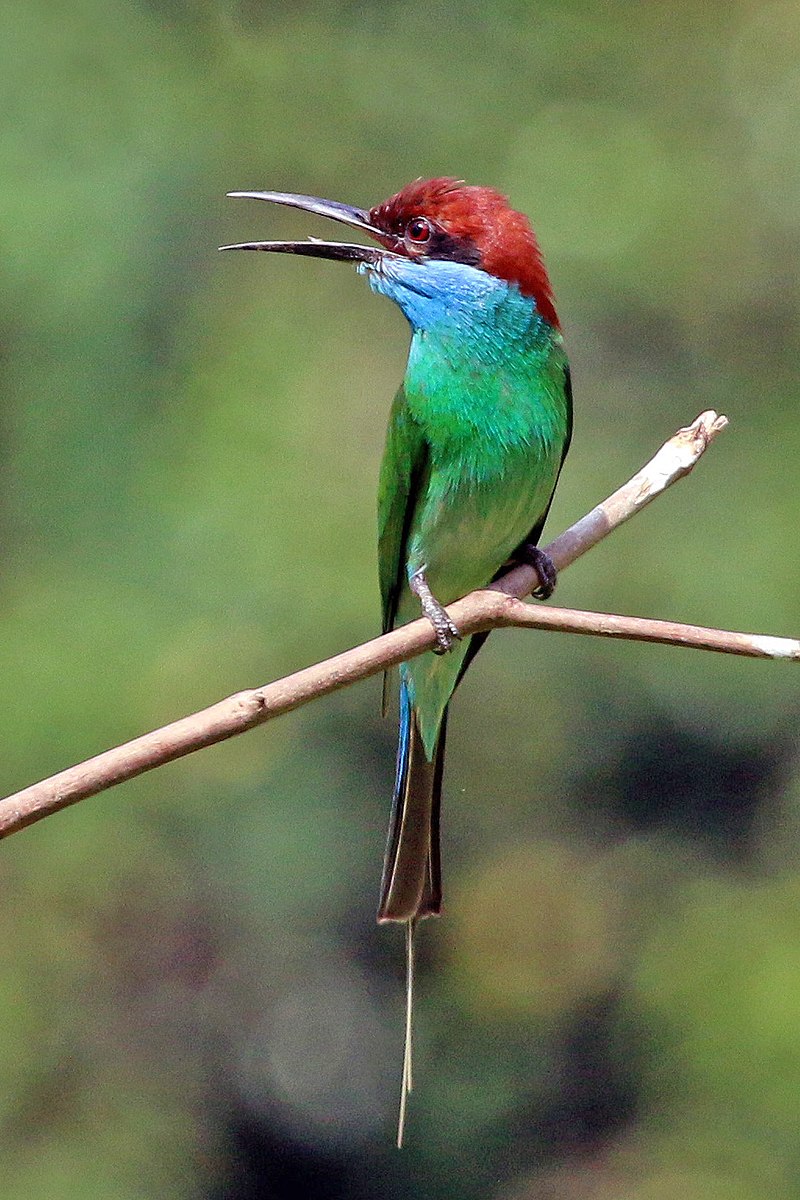
The beautiful Blue-throated bee-eater is a species of bird found in southeast Asia. These small birds have vibrant plumage, with a red nape, dark green wings and light green breast – but their signature feature is the bright blue throat.
Immature individuals are slightly different in appearance to adults; they are mostly brown with yellow markings on their face and chest.
Their diet consists mainly of bees, wasps and dragonflies which they catch while flying through the air or by snatching them from branches as they perch near flowers.
They usually live in mangrove forests where there are plenty of insects for them to feed on. The Blue-throated bee-eater is an interesting bird that can be easily recognised due its unique coloration making it stand out amongst other species.
Scientific classification:
| Kingdom | Animalia |
| Phylum | Chordata |
| Class | Aves |
| Order | Coraciiformes |
| Family | Meropidae |
| Genus | Merops |
| Species | M. viridis |
14. Black-Winged Kite
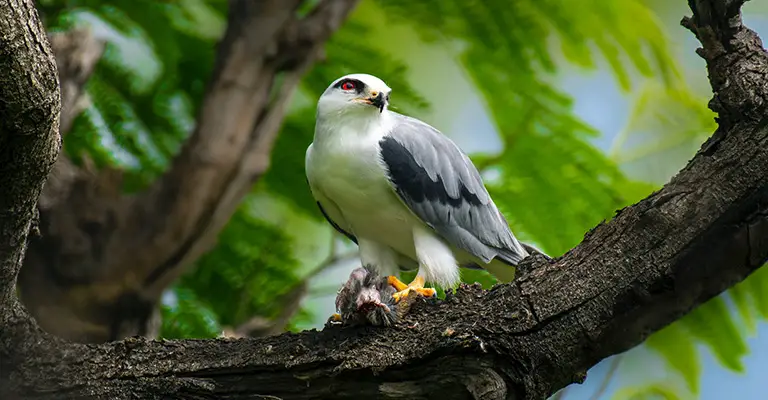
The Black-winged Kite is a small, diurnal bird of prey in the Accipitridae family. It can be found throughout Palearctic and Afrotropical regions.
This species stands out from other birds of prey due to its unique ability to hover over open grasslands like kestrels do.
Its wings are black with white patches on them while its body has gray feathers, giving it a distinct look from the rest of the accipiters.
The underside is mostly white with some barring near the tail area that helps distinguish this species from others.
They feed mainly on insects but will also eat rodents, lizards and even snakes if they come across one.
Because these birds hunt during daylight hours, their diet changes as time passes by – making them quite adaptive hunters.
Scientific classification:
| Kingdom | Animalia |
| Phylum | Chordata |
| Class | Aves |
| Order | Accipitriformes |
| Family | Accipitridae |
| Genus | Elanus |
| Species | E. caeruleus |
15. Oriental Pied Hornbill
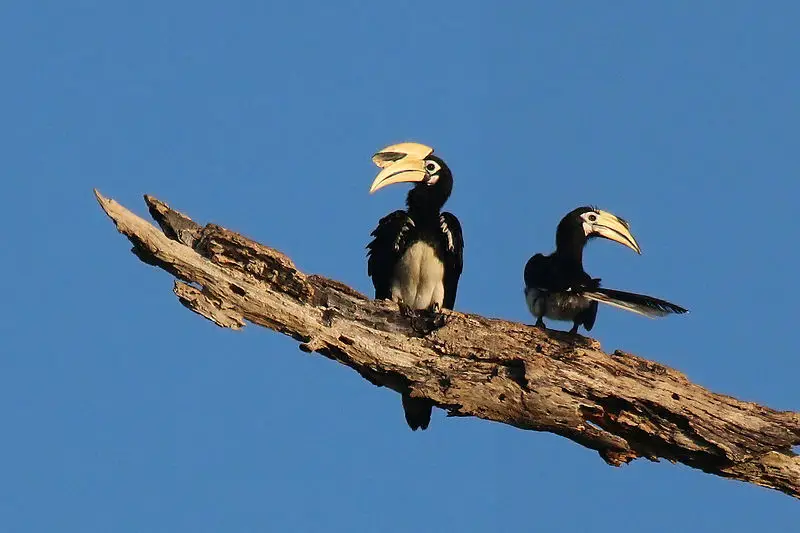
The Oriental Pied Hornbill is a species of Indo-Malayan bird belonging to the Bucerotidae family.
It’s one of the smallest and most common Asian hornbills, with its largest distribution found in the genus Anthracoceros.
This medium sized bird has black feathers all over its body, except for white wings and a white tail that make it stand out from other birds.
Its bill is yellow on top and red underneath, while their feet are greyish black.
These colorful characteristics help them blend into various habitats such as tropical forests or woodlands.
The diet consists mainly of fruits but they also feed on insects and small vertebrates like lizards or nesting birds’ eggs when available during certain seasons throughout their range habitat areas.
Monogamous pairs of birds construct their nests together using dead branches to create a secure chamber where the female can lay her eggs.
They carefully tend to the eggs until they hatch, and then rejoin their partner at nightfall.
These nests are often located near sources of food, in the beautiful and picturesque surroundings of trees and landscapes. These locations provide stunning views and make for attractive tourist destinations.
The scenery is breathtakingly beautiful, with spectacular vistas and awe-inspiring panoramas that are sure to captivate and charm visitors.
The overall atmosphere of these locations is heavenly and paradisiacal, making them a delight to behold.
The incredible beauty and grace of these places are simply remarkable, and visitors are sure to be impressed by their elegance and distinguished grandeur.
It is an experience that is sure to leave a lasting impression on anyone who is lucky enough to visit.
Scientific classification:
| Kingdom | Animalia |
| Phylum | Chordata |
| Class | Aves |
| Order | Bucerotiformes |
| Family | Bucerotidae |
| Genus | Anthracoceros |
| Species | A. albirostris |
16. Greater Coucal
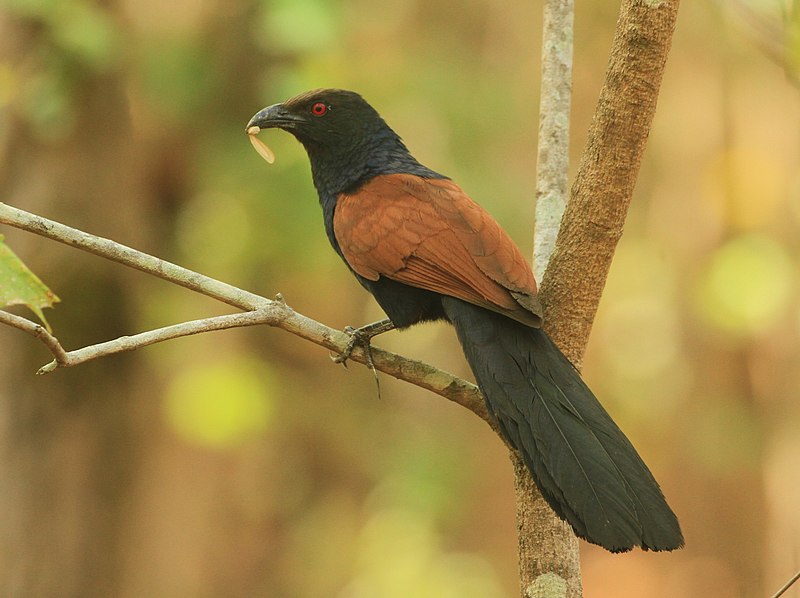
The Greater Coucal is a large, crow-like bird that belongs to the Cuculiformes order. It has a long tail and coppery brown wings.
These birds are found in many habitats across India and Southeast Asia, ranging from jungles to suburban gardens.
They feed on insects as well as small vertebrates such as frogs, lizards or snakes which they capture with their strong beak.
The males have glossy black plumage while females are dark brown above with buff underparts.
During breeding season these birds make loud croaking calls and can often be heard at night when they become active after sundown looking for food sources like termites or grasshoppers between bushes or low branches of trees close by water bodies like rivers, lakes etc.
This species plays an important role in maintaining ecological balance in its habitat by controlling pest populations through predation so it is essential that we protect them from hunting and other threats for future generations to enjoy.
Scientific classification:
| Kingdom | Animalia |
| Phylum | Chordata |
| Class | Aves |
| Order | Cuculiformes |
| Family | Cuculidae |
| Genus | Centropus |
| Species | C. sinensis |
17. Red Junglefowl
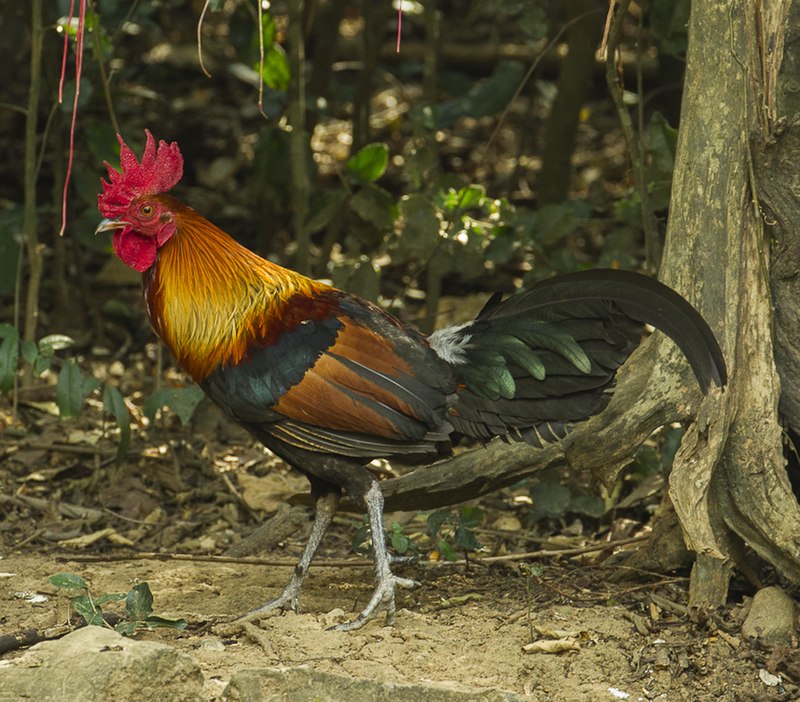
The Red Junglefowl is a tropical bird belonging to the Phasianidae family, native to much of Southeast Asia and parts of South Asia. It has been referred to as Bankiva or Bankiva Fowl in the past.
This species was instrumental in giving rise to chickens (Gallus gallus domesticus) that are commonly domesticated today.
In addition, it has contributed genetic material along with Grey Junglefowl, Sri Lankan Junglefowl and Green Junglefowl towards creation of various breeds found around the world.
The male red jungle fowls have a distinctive long tail while they also boast iridescent patches on their neck feathers which develop during mating season for display purposes.
They mainly feed on plants & insects but may occasionally consume lizards too.
Scientific classification:
| Kingdom | Animalia |
| Phylum | Chordata |
| Class | Aves |
| Order | Galliformes |
| Family | Phasianidae |
| Genus | Gallus |
| Species | G. gallus |
18. Buffy Fish Owl
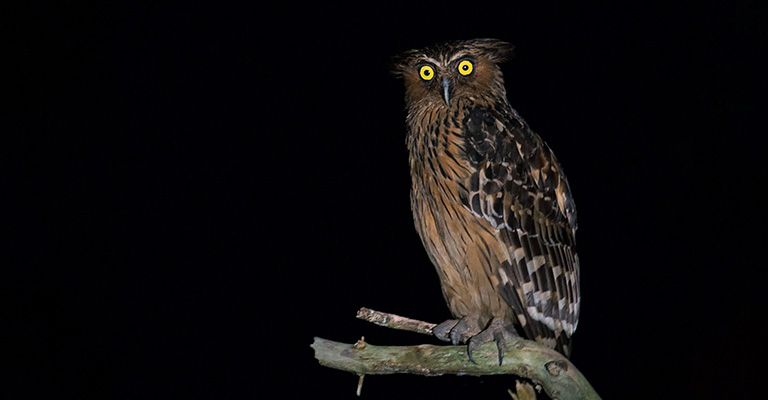
The Buffy Fish Owl is a large fish owl belonging to the family Strigidae. It is native to Southeast Asia and can be found in tropical forests and wetlands.
This species has an impressive wingspan of up to 1 meter, with its distinctive yellow eyes giving it away from other owls.
They feed mainly on small fishes, frogs, crustaceans as well as insects which they hunt near water sources at night time.
Although their population appears stable according to IUCN Red List 2004 listing them under Least Concern category, habitat destruction due logging activities remains one of the main causes for concern regarding this species’ long term survival in the wild.
Scientific classification:
| Kingdom | Animalia |
| Phylum | Chordata |
| Class | Aves |
| Order | Strigiformes |
| Family | Strigidae |
| Genus | Ketupa |
| Species | K. ketupu |
19. Barred Buttonquail
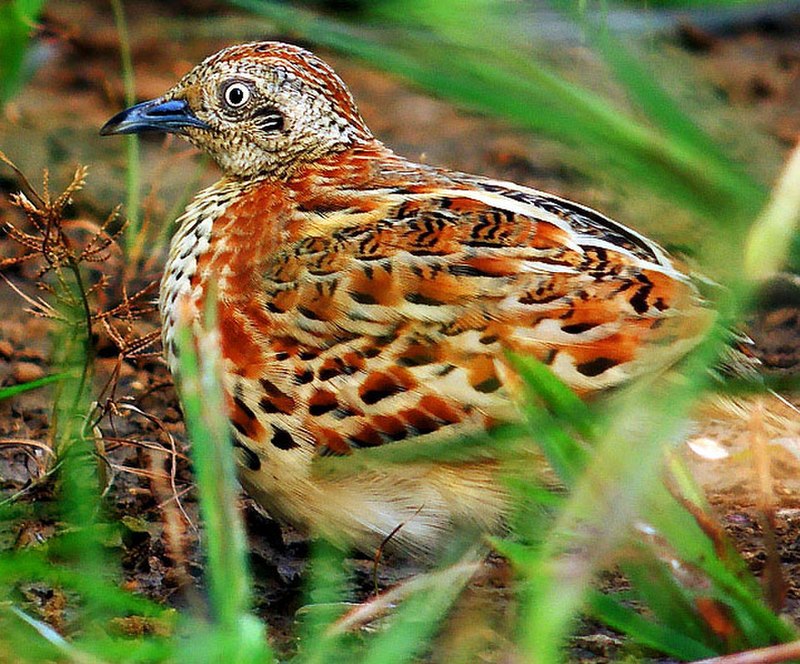
The Barred Buttonquail, also known as the Common Bustard-Quail is a small species of bird that originates in India and extends across tropical Asia to South China, Indonesia and the Philippines.
It was formally described by German naturalist Johann Friedrich Gmelin in 1789.
This buttonquail looks similar to true quails but it belongs to its own family; they have brown plumage with black barring on their wings and tail feathers.
They mainly feed on insects like beetles, grasshoppers and other invertebrates found amongst leaf litter or tall vegetation cover.
Their diet also includes grains such as wheat or corn for added nutrition during breeding season when females are laying eggs for incubation purposes until hatching occurs after about 18 days.
Scientific classification:
| Kingdom | Animalia |
| Phylum | Chordata |
| Class | Aves |
| Order | Charadriiformes |
| Family | Turnicidae |
| Genus | Turnix |
| Species | T. suscitator |
Also Featured In: Birds of Goa, Birds that Commonly Found in Bali
20. Sunda Scops Owl
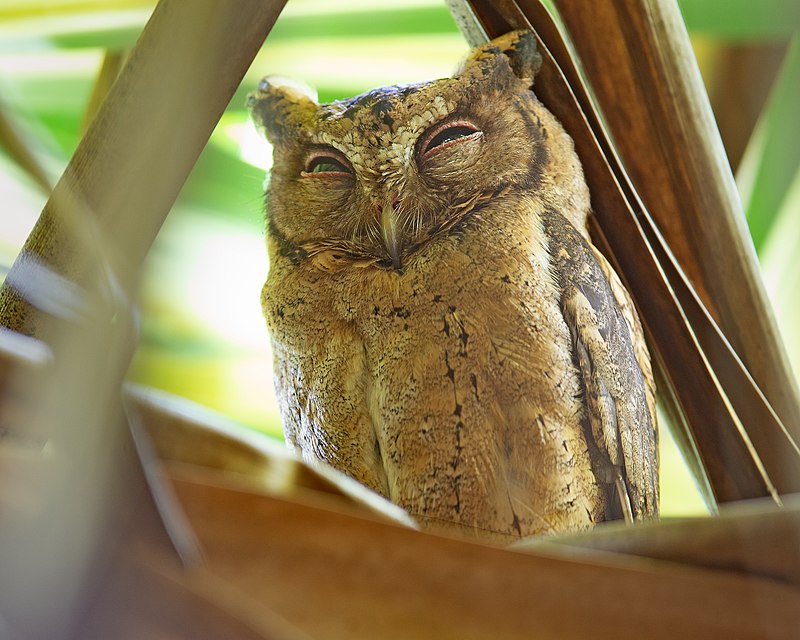
The Sunda scops owl is a small, brown species native to the Sunda Islands. Growing up to 25 cm in length and weighing between 100-170 grams, this distinctive bird has speckled black upper parts and dark streaked lower body feathers with a light collar around its neck.
Its unique dark eyes are one of the key features that sets it apart from other owls found in similar habitats.
It inhabits tropical evergreen forests as well as agricultural areas such as coconut plantations or rubber tree stands – where food sources like insects, reptiles and amphibians can be located easily by these nocturnal hunters.
Scientific classification:
| Kingdom | Animalia |
| Phylum | Chordata |
| Class | Aves |
| Order | Strigiformes |
| Family | Strigidae |
| Genus | Otus |
| Species | O. lempiji |
21. Black Hornbill
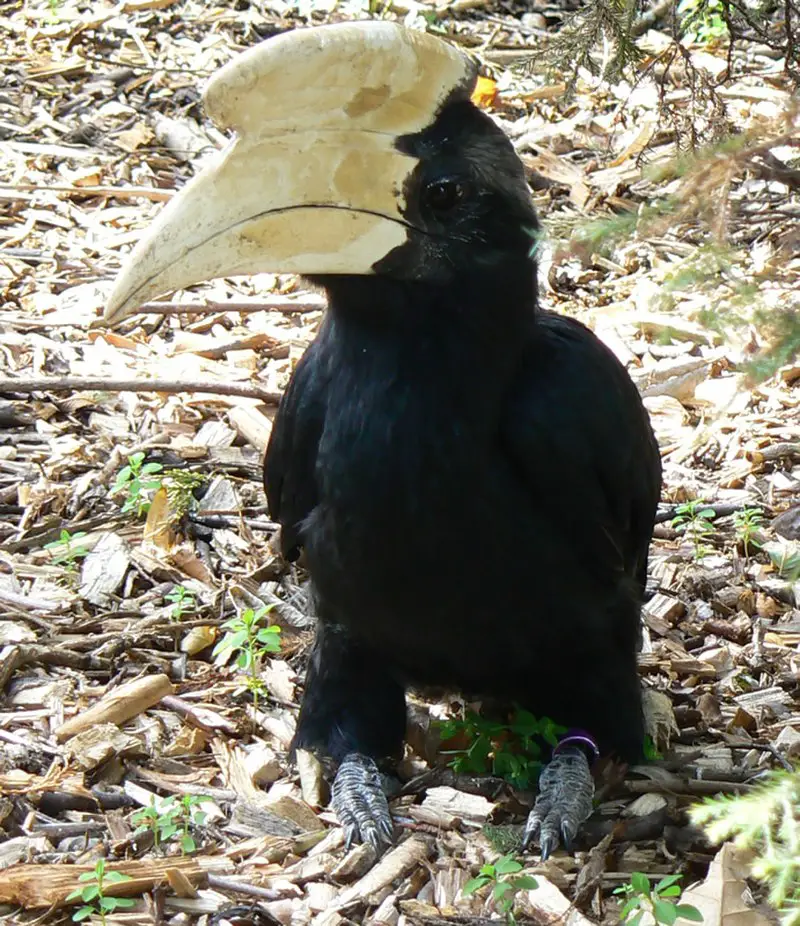
The Black Hornbill is an impressive species of bird found within Southeast Asia. Its distinctive black body and casque-shaped beak make it a truly striking creature.
Unlike other hornbills, the Black Hornbill has quite specific requirements when it comes to breeding and nesting; they only do so if there is an ample supply of fruit in their environment.
These birds are frugivores, meaning that fruits form a major part of their diet as well as being important for the successful rearing of younglings during mating season.
They mainly inhabit tropical rainforests but have been known to roam into more open areas on occasion too.
The conservation status for this species remains vulnerable due to deforestation caused by human activities like logging and agriculture practices which threaten its natural habitat – making us all responsible for protecting these beautiful creatures from extinction.
Scientific classification:
| Kingdom | Animalia |
| Phylum | Chordata |
| Class | Aves |
| Order | Bucerotiformes |
| Family | Bucerotidae |
| Genus | Anthracoceros |
| Species | A. malayanus |
22. Asian Openbill
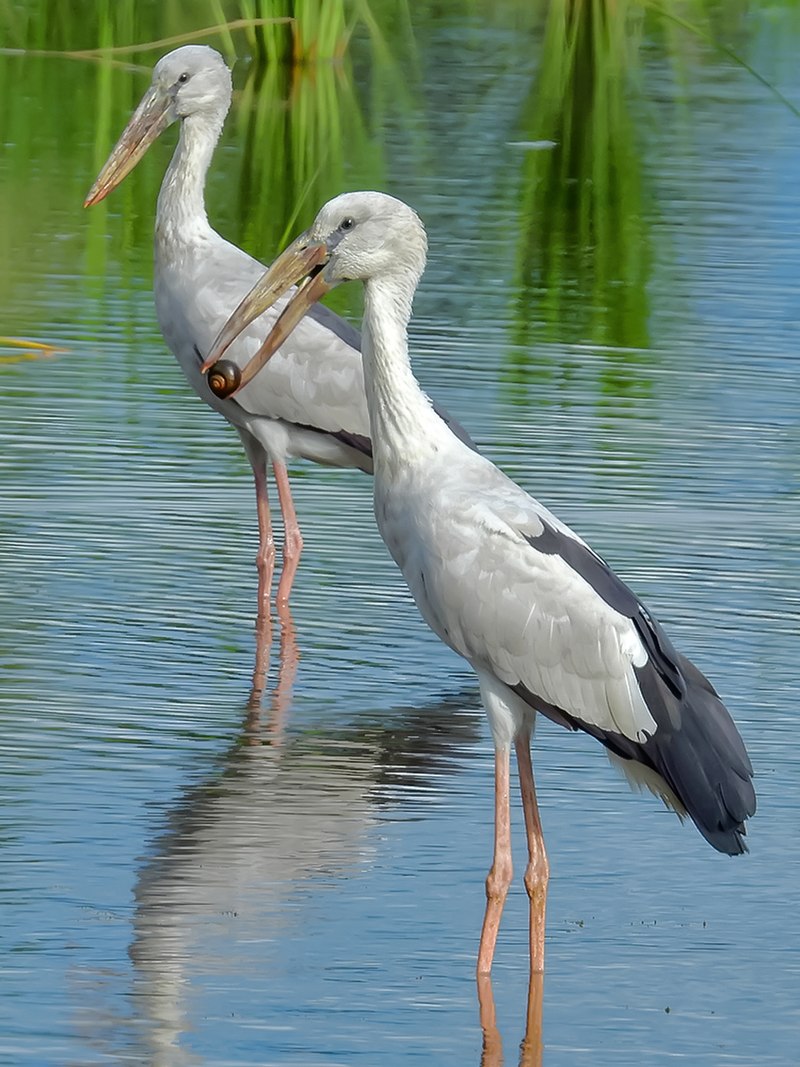
The Asian openbill is a large stork found in the Indian subcontinent and Southeast Asia. It has a greyish or white body, glossy black wings and tail, with an adult having a gap between upper mandible and lower one.
Juveniles don’t have this unique feature but will grow it as they mature.
They feed by wading through shallow water looking for snails, crustaceans and aquatic plants to eat from the surface of mudflats or marshes.
Due to its enormous size (up to 121 cm tall) it makes quite an impressive sight when flying.
Scientific classification:
| Kingdom | Animalia |
| Phylum | Chordata |
| Class | Aves |
| Order | Ciconiiformes |
| Family | Ciconiidae |
| Genus | Anastomus |
| Species | A. oscitans |
23. Oriental Dollarbird
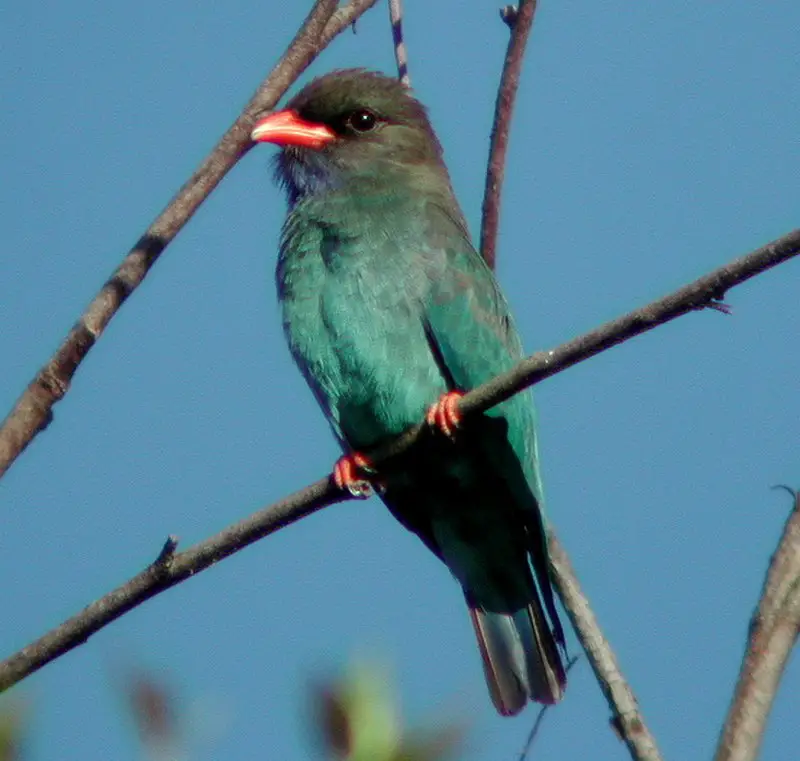
The Oriental dollarbird is a beautiful member of the roller family, easily identified by its pale blue or white coin-shaped spots on its wings.
This species can be found in many places ranging from Australia to Korea, Japan and India.
It was first classified by the Swedish naturalist Carl Linnaeus in 1766 as Coracias orientalis. The bird has an impressive wingspan that helps it soar through the sky with ease.
Its diet consists mainly of insects which it catches mid flight during hunting expeditions for food.
Although shy around people, this mesmerizing creature will fly close enough to humans at times so they can observe them better and appreciate their unique beauty up close.
Scientific classification:
| Kingdom | Animalia |
| Phylum | Chordata |
| Class | Aves |
| Order | Coraciiformes |
| Family | Coraciidae |
| Genus | Eurystomus |
| Species | E. orientalis |
24. Tiger Shrike
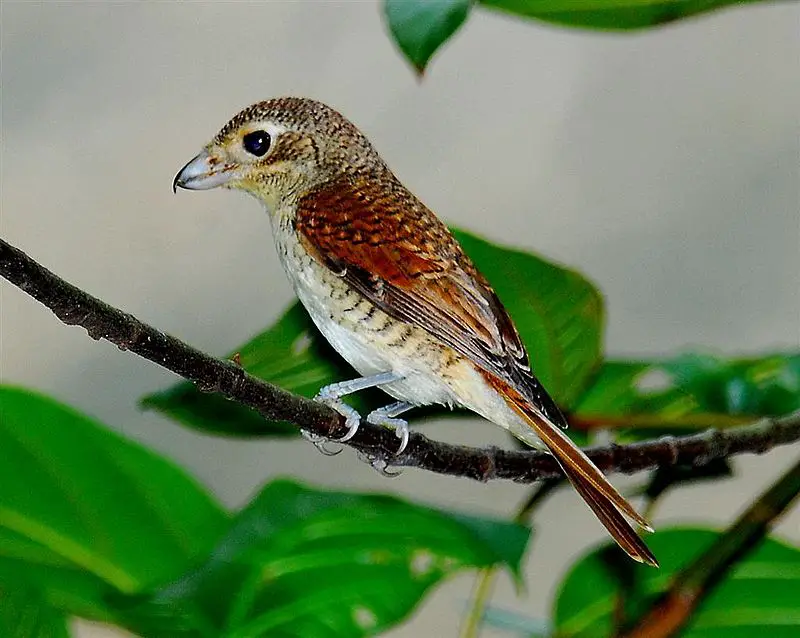
The Tiger Shrike is a small passerine bird found across eastern Asia in wooded habitats. It has pale grey upperparts and white underparts, with black streaks on its wings and tail.
Its head is distinctive – dark crown and nape surrounded by an orange-buff face mask which fades to yellowish-white around the eyes, cheeks and throat.
This shy shrike typically hunts alone, preying upon smaller animals such as insects or lizards.
During mating season it builds its nest high up in trees where it will lay 3-6 eggs at once before incubating them until hatching takes place about 2 weeks later.
The species may be lesser known than other shrikes but this does not diminish their importance to local ecosystems.
Scientific classification:
| Kingdom | Animalia |
| Phylum | Chordata |
| Class | Aves |
| Order | Passeriformes |
| Family | Laniidae |
| Genus | Lanius |
| Species | L. tigrinus |
25. Mountain Imperial Pigeon
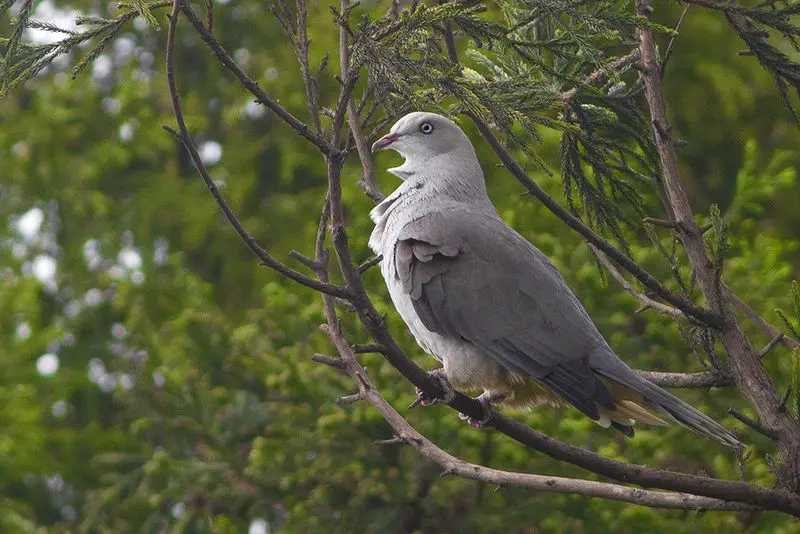
The Mountain Imperial Pigeon is a species of bird in the Dove family, found across Southeast Asia. It has distinct maroon-backed feathers and can be easily recognized by its bright eyes and yellowish bill.
The bird feeds primarily on fruits and nuts from trees, such as figs, mangoes and coconuts. Its habitat consists of tropical forests near mountains or hillsides with plenty of foliage for it to feed on.
Recently, the Malabar Imperial Pigeon was separated into its own species due to differences between them observed in their plumage colouring; they both have similar diets however.
This majestic pigeon stands out amongst other birds due to its striking colours that make it an eye-catching sight within any environment.
Scientific classification:
| Kingdom | Animalia |
| Phylum | Chordata |
| Class | Aves |
| Order | Columbiformes |
| Family | Columbidae |
| Genus | Ducula |
| Species | D. badia |
Also Featured In: Imperial Birds You Should Know, Birds that Commonly Found in Andhra Pradesh
26. Laced Woodpecker
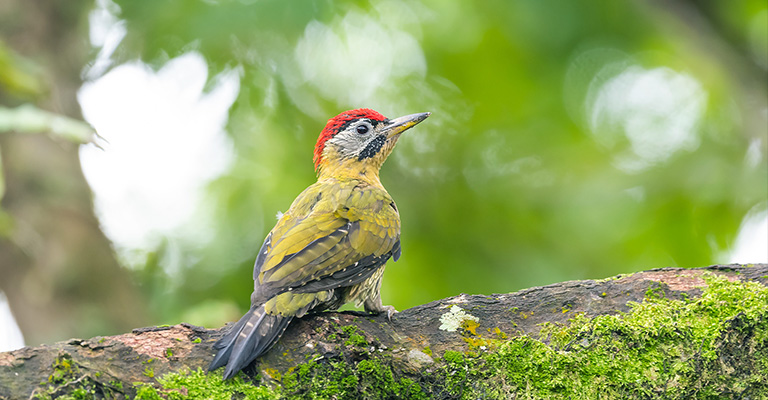
The Laced Woodpecker is a species of bird found in Southeast Asia. It inhabits subtropical and tropical dry forests, sub-tropical or tropical moist lowland forests, and mangrove forests.
This beautiful bird has white wings with black spotting on its back, while the head features a red crown which contrasts against its grey face.
Its underside is also spotted with black markings that cover the chest to the tail feathers.
The male birds have an additional yellow patch near their shoulder blades which makes them easily distinguishable from females.
Due to deforestation, this majestic species faces threats such as habitat loss leading it to be listed as “Near Threatened” by IUCN Red List of Threatened Species .
Scientific classification:
| Kingdom | Animalia |
| Phylum | Chordata |
| Class | Aves |
| Order | Piciformes |
| Family | Picidae |
| Genus | Picus |
| Species | P. vittatus |
27. Black Drongo

The Black Drongo is a small passerine bird of the Dicruridae family, commonly found in tropical southern Asia from Iran through India and Bangladesh to Indonesia.
It has an all black plumage and distinctive forked tail measuring 28 cm long. This omnivorous species feeds on insects such as flies, bees, beetles and moths; it also consumes fruit juices during summer months.
The nest can be built anywhere including open fields or near houses made up of twigs with a cup-shaped inner lining using grasses & hair filled with feathers & cobwebs.
During breeding season they are known to perform aerial acrobatics while chasing away any intruders who come too close to their nests.
Scientific classification:
| Kingdom | Animalia |
| Phylum | Chordata |
| Class | Aves |
| Order | Passeriformes |
| Family | Dicruridae |
| Genus | Dicrurus |
| Species | D. macrocercus |
28. Eurasian Whimbrel
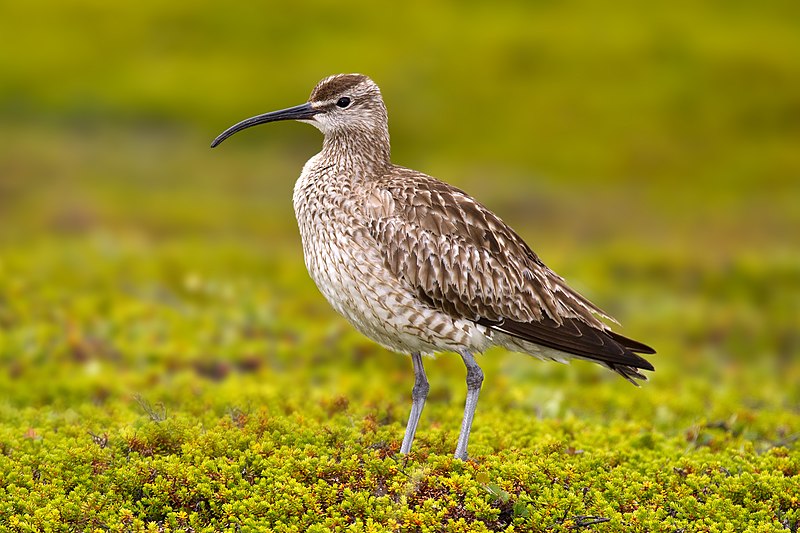
Eurasian Whimbrels are a species of wading bird commonly found in subarctic regions of Europe and Asia.
They have white rumps, long curved bills, brown wings and backs with light streaking on the lower breast.
These birds feed mainly on crustaceans, mollusks or worms they find while probing in the mud during low tide.
During breeding season they can be seen nesting near coastal areas or wetlands where food is plentiful.
This species has recently been split from Hudsonian whimbrels but some authorities still consider them to be one species due to their similarities which includes migration patterns as well as habitat preferences.
Eurasian whimbrels are an important part of many ecosystems because they help control insect populations by eating larvae before it can cause damage to crops or vegetation nearby.
Scientific classification:
| Kingdom | Animalia |
| Phylum | Chordata |
| Class | Aves |
| Order | Charadriiformes |
| Family | Scolopacidae |
| Genus | Numenius |
| Species | N. phaeopus |
Also Featured In: Galapagos Birds You Should Know, Birds that Live in San Francisco Bay Area
29. Black-Naped Monarch
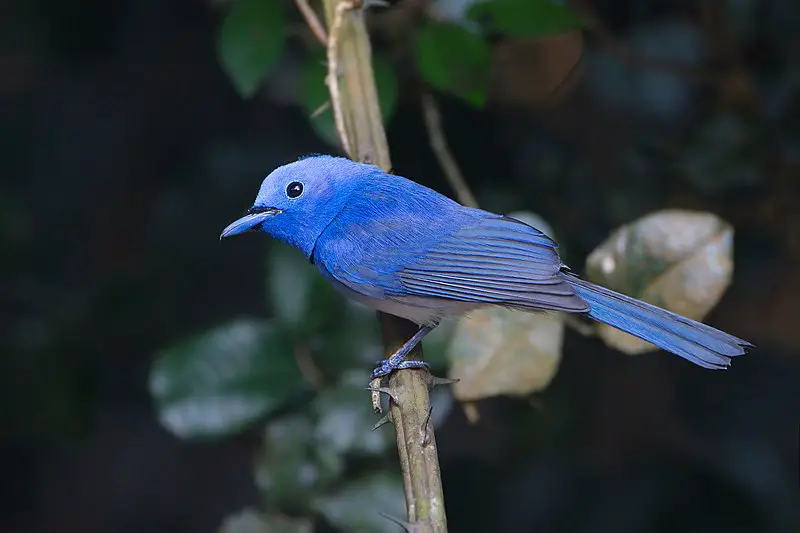
The Black-naped Monarch is a beautiful and agile passerine bird native to Southern and South East Asia.
With its distinct black patch on the back of it’s head, this small but strong species stands out among other birds in the area.
The male has vibrant blue plumage with an elegant narrow black half collar (“necklace”) which makes him even more attractive.
Females are comparatively duller with olive brown wings and light yellowish underparts which helps them blend into their environment better for camouflage purposes.
These birds feed mainly on insects, spiders and fruits making them beneficial as they help reduce pests while also providing nutrients to local vegetation by dispersing seeds from fruit consumption.
Scientific classification:
| Kingdom | Animalia |
| Phylum | Chordata |
| Class | Aves |
| Order | Passeriformes |
| Family | Monarchidae |
| Genus | Hypothymis |
| Species | H. azurea |
Also Featured In: Most Common Taiwan Birds, Gujarati Birds
30. Coraciiformes
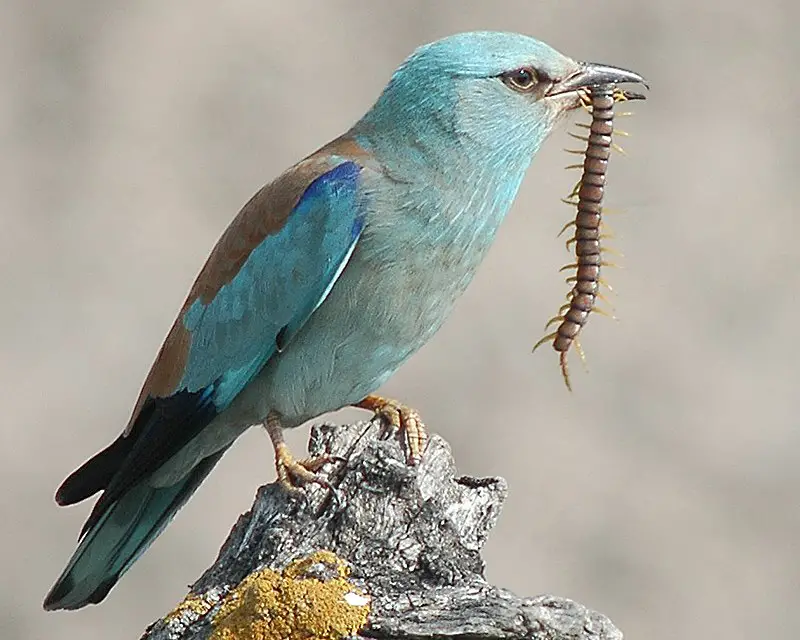
Coraciiformes birds are a group of beautiful and vibrant species, including kingfishers, bee-eaters, rollers, motmots and todies. They have syndactyly feet with three forward pointing toes (with their third and fourth fused at the base).
However in some kingfisher species one toe is absent. This order of bird has an interesting behavior known as ‘slamming’ which links them all together.
These amazing creatures can be seen across many parts of the world from forests to deserts.
Their colorful feathers make them stand out amongst other birds making sure they don’t go unnoticed.
Scientific classification:
| Kingdom | Animalia |
| Phylum | Chordata |
| Class | Aves |
| Clade | Picodynastornithes |
| Order | Coraciiformes Forbes, 1884 |
31. Northern Boobook
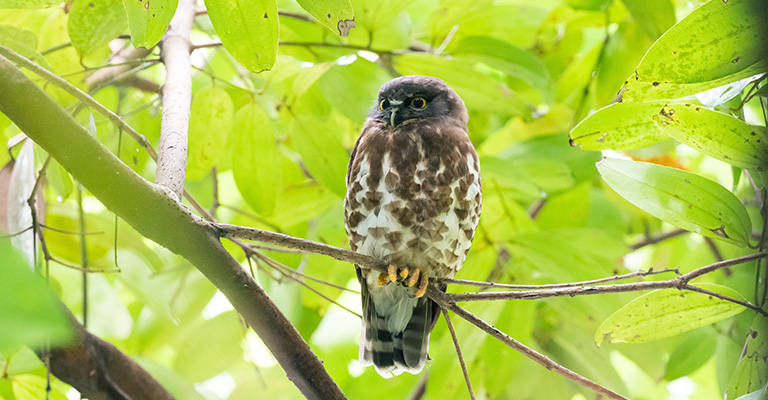
The Northern Boobook is a species of raptorial owl that is native to eastern and southern Asia.
It was formerly considered part of the Brown Boobook, but has recently been identified as its own separate species with two distinct subspecies.
Its plumage varies from yellowish-brown or grey on top and lighter underneath.
They have bright orange eyes and white eyebrows which gives them an easily recognizable look in their natural habitat.
The Northern Boobook can be found living among forests near streams, open woodlands, agricultural areas and at times will even venture into inhabited urban landscapes looking for food sources such as mice, frogs or insects.
This bird often makes use of man made structures like tree hollows created by humans when selecting nesting sites however they are currently threatened due to deforestation practices across many parts of their range where suitable habitats are being destroyed at rapid rates without proper environmental stewardship initiatives put in place first.
Scientific classification:
| Kingdom | Animalia |
| Phylum | Chordata |
| Class | Aves |
| Order | Strigiformes |
| Family | Strigidae |
| Genus | Ninox |
| Species | N. japonica |
Also Featured In: Birds Commonly Found in Kyoto,
32. Common Redshank
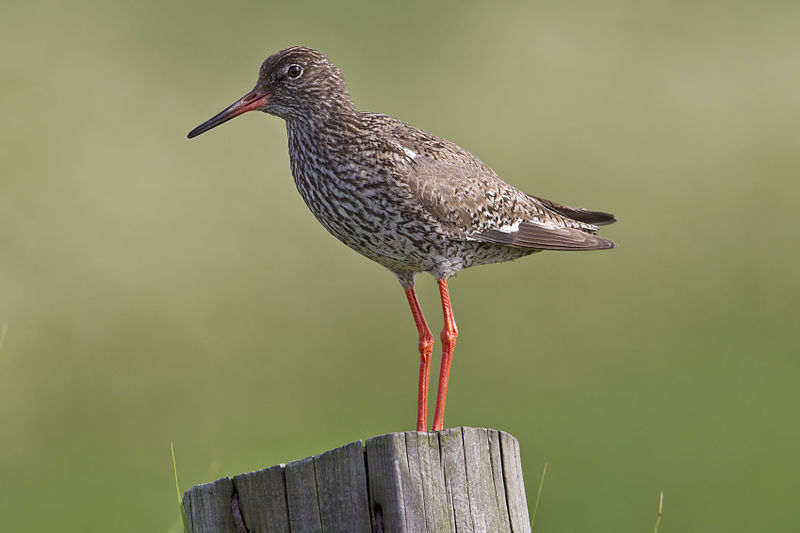
The Common Redshank is a wading bird found in Eurasia. It has long, red legs and dark grey wings. The body of the bird is brownish-grey with white patches on its sides and back.
Its bill is pointed and yellow to orange in colour, while its eyes are black or dark brown.
During migration they can be seen around coasts, estuaries and marshes where they feed mainly on small aquatic invertebrates such as worms, crustaceans and molluscs which it finds by probing mudflats with its bill.
They nest near wetland areas laying two to four eggs at a time during April or May depending on their location within Europe/Asia.
Redshanks often form large flocks when migrating southwards for wintering grounds in Africa or Asia making them easily visible from shorelines
Scientific classification:
| Kingdom | Animalia |
| Phylum | Chordata |
| Class | Aves |
| Order | Charadriiformes |
| Family | Scolopacidae |
| Genus | Tringa |
| Species | T. totanus |
33. Blue-Crowned Hanging Parrot
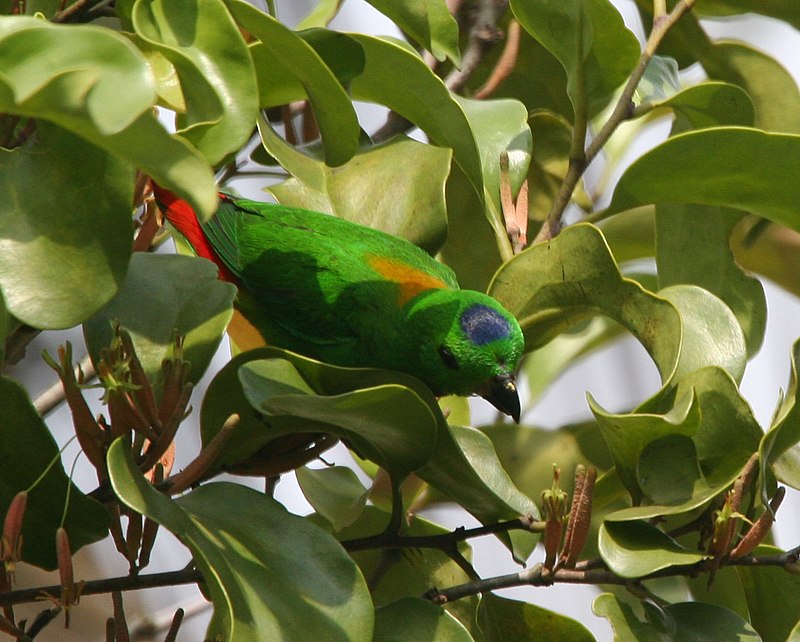
The Blue-crowned hanging parrot is a beautiful and unique species of bird found in Southeast Asia. It stands at 12 cm tall and can weigh up to 28 g, with an average lifespan of 14 years.
They are easily recognizable due to their green plumage combined with black beaks and distinctive blue feathers arranged like a crown on their heads – giving them the name “Blue-crowned”.
These birds inhabit forests from Southern Burma to Thailand, Malaya, Singapore and Indonesia (Sumatra, Java & Borneo) where they feed mainly on fruits such as figs or bananas as well as insects for protein.
The Blue-crowned Hanging Parrots have adapted over time so that they can hang upside down while eating or preening themselves.
Scientific classification:
| Kingdom | Animalia |
| Phylum | Chordata |
| Class | Aves |
| Order | Psittaciformes |
| Family | Psittaculidae |
| Genus | Loriculus |
| Species | L. galgulus |
34. Grey-Streaked Flycatcher
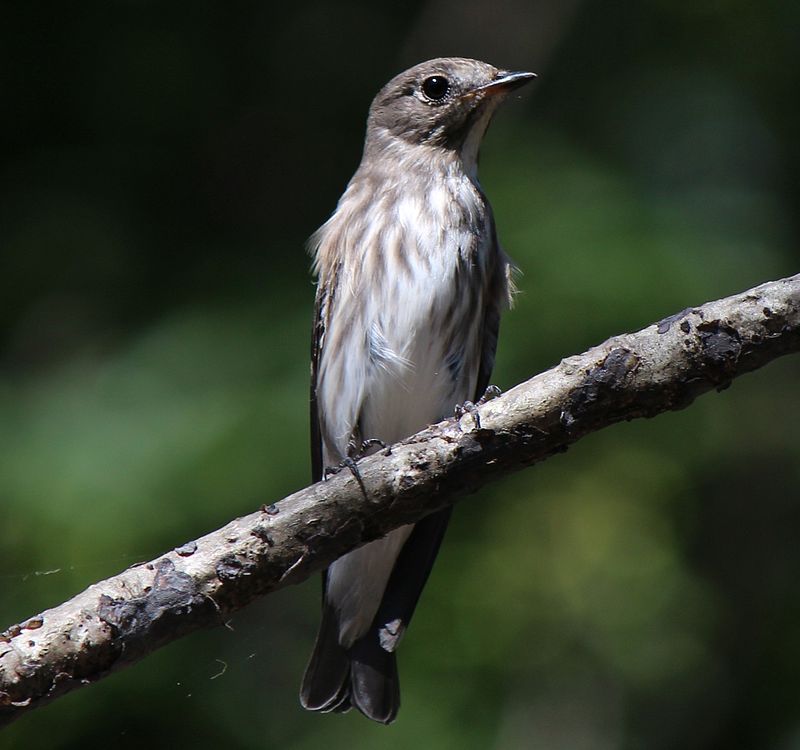
The Grey-streaked Flycatcher is a small passerine bird found in the eastern Palearctic. It has a slender build and long wings, measuring between 13 to 15 cm in length.
Its main plumage consists of grey brown above, with white underneath and distinct streaks on its back that give it its name.
During breeding season males take on an orange colouration as part of their mating display which helps attract females.
They are insectivores foraging for food both from trees or flying insects midair during flight – often hovering near tree branches before dropping down onto prey like other flycatchers do.
Outside breeding season they travel southwards and can be seen far from home all over Asia where they rest until returning north again come springtime.
Scientific classification:
| Kingdom | Animalia |
| Phylum | Chordata |
| Class | Aves |
| Order | Passeriformes |
| Family | Muscicapidae |
| Genus | Muscicapa |
| Species | M. griseisticta |
35. Common Tailorbird
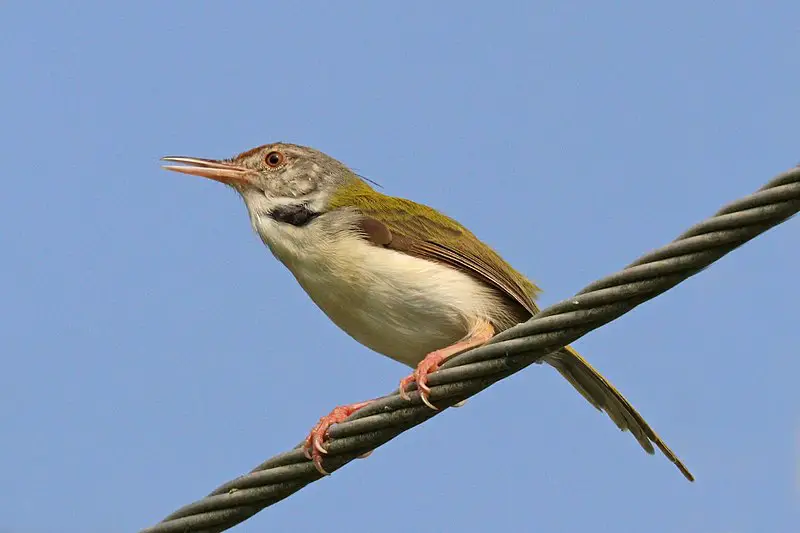
The Common Tailorbird is a songbird found across tropical Asia, popular for its unique nests made of leaves “sewn” together.
It was immortalized by Rudyard Kipling in his Jungle Book as Darzee and can often be seen in urban gardens.
Though shy birds that are usually hidden within vegetation, their loud calls give away their presence.
They are distinctive with a brownish plumage on the upperparts and paler gray underparts; white throats speckled black mark them out from other similar species.
They feed mainly on insects such as spiders, caterpillars and grasshoppers but will also eat fruit when available.
Breeding season begins around March or April with males singing to claim territories before beginning to weave intricate leafy structures for nesting sites – an amazing feat.
All in all these delightful little birds make wonderful additions to any garden setting – just remember not to get too close.
Scientific classification:
| Kingdom | Animalia |
| Phylum | Chordata |
| Class | Aves |
| Order | Passeriformes |
| Family | Cisticolidae |
| Genus | Orthotomus |
| Species | O. sutorius |
36. White-Crested Laughingthrush
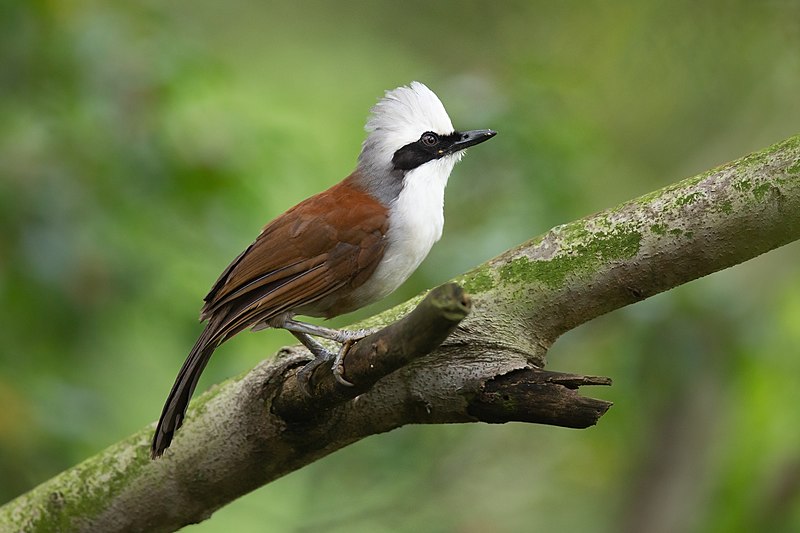
The white-crested laughingthrush is a highly social and vocal bird found in forest and scrub from the Himalayan foothills to Southeast Asia. It belongs to the family Leiothrichidae, which was recently split off from Timaliidae — an Old World babbler family.
The scientific name of this species is Garrulax leucolophus. The plumage varies between greyish brown upperparts with darker wings, black tail feathers tipped white and streaked breast.
Its head has a distinctive white crown that distinguishes it as one of few laughing thrush species with such feature.
These birds are sociable creatures often seen foraging together in small groups or pairs during their daily activities like looking for food on ground or taking insects from trees; they also have melodious calls that make them easily recognizable in bushlands.
Scientific classification:
| Kingdom | Animalia |
| Phylum | Chordata |
| Class | Aves |
| Order | Passeriformes |
| Family | Leiothrichidae |
| Genus | Garrulax |
| Species | G. leucolophus |
37. Rose-Ringed Parakeet
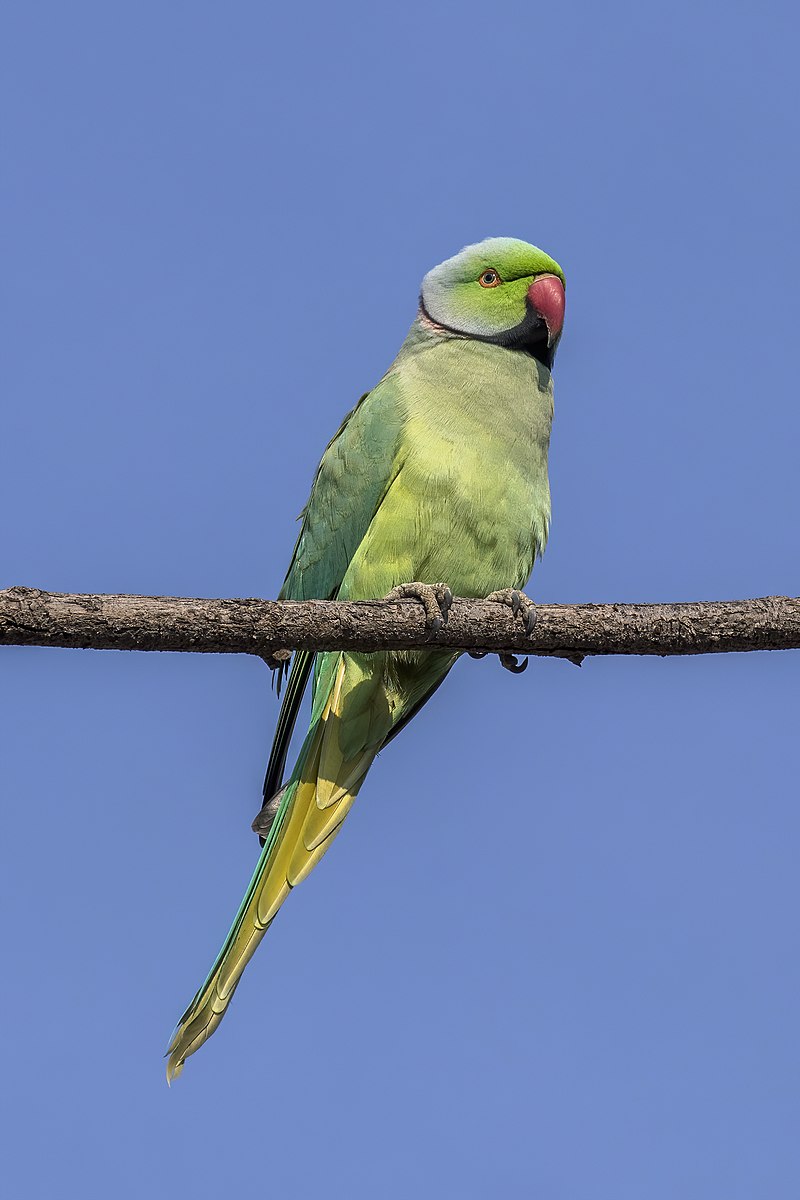
The Rose-ringed parakeet is a medium sized bird in the family Psittacidae. Native to Africa and India, it has been introduced into many other parts of the world where feral populations have now established themselves.
The most distinctive feature of this species is its colorful neck ring ranging from pink to purple which gives them their name.
However, males often display more vibrant colors than females do. This beautiful bird can also imitate human speech quite well making them popular pets worldwide.
In addition they are very social creatures preferring large flocks when out in nature or as part of aviaries during captivity. With proper care these birds can live up to 30 years.
Scientific classification:
| Kingdom | Animalia |
| Phylum | Chordata |
| Class | Aves |
| Order | Psittaciformes |
| Family | Psittaculidae |
| Genus | Psittacula |
| Species | P. krameri |
38. White-Throated Kingfisher
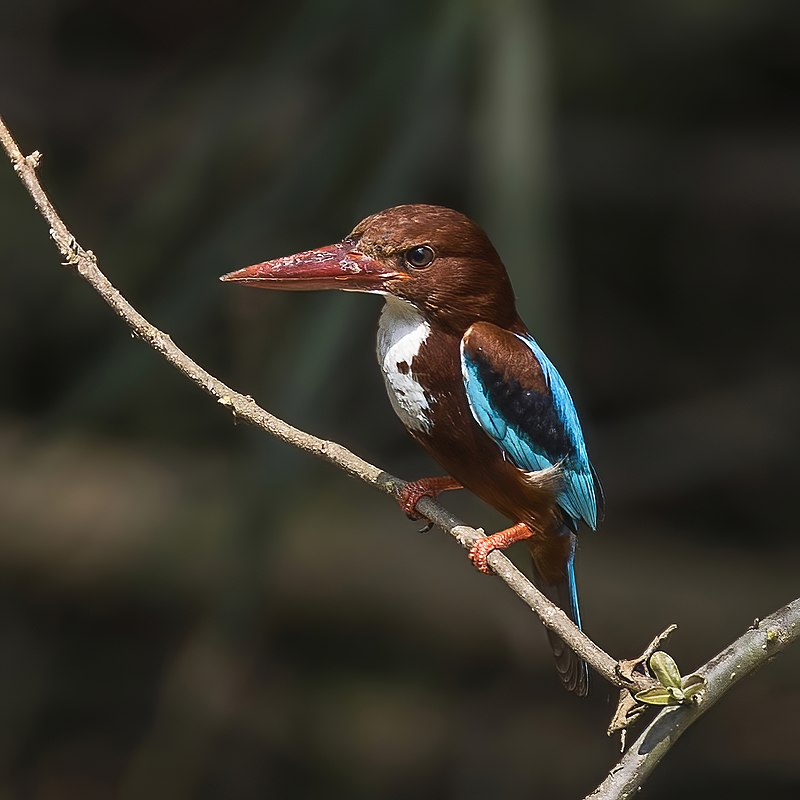
The White-throated Kingfisher is a beautiful bird with bright colors and distinct features. Its back, wings and tail are a deep blue while the head, breast, throat and belly are white.
It has two black stripes across its eyes which contrast nicely against its orange beak and feet.
These birds can often be found perching on tree branches or hovering over creeks in search of food like fish or small insects such as grasshoppers or crickets.
They use their sharp bill to pluck prey from water surfaces then swallow them whole after making adjustments for size by beating it against rocks if necessary.
The White-throated Kingfisher breeds during monsoon season when rainfall increases levels in rivers leading to an abundance of aquatic life that these birds love so much.
Scientific classification:
| Kingdom | Animalia |
| Phylum | Chordata |
| Class | Aves |
| Order | Coraciiformes |
| Family | Alcedinidae |
| Subfamily | Halcyoninae |
| Genus | Halcyon |
| Species | H. smyrnensis |
39. Piciformes
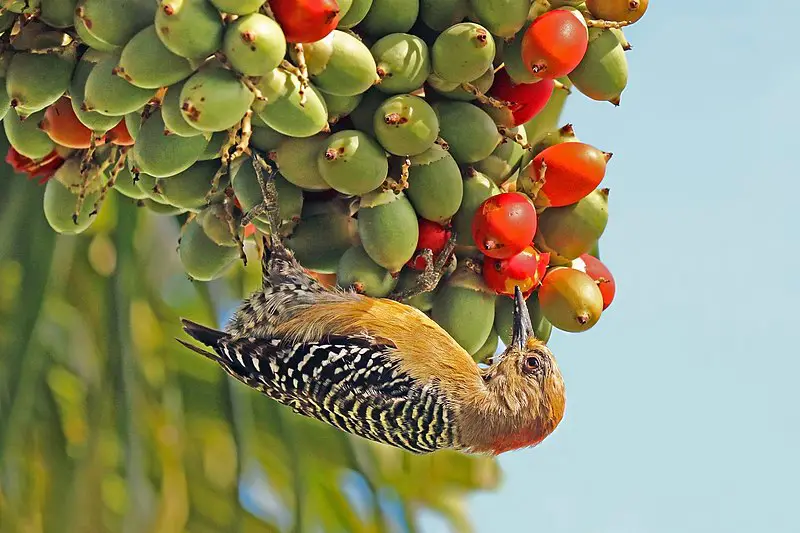
Piciformes are a diverse order of birds that includes the woodpeckers, barbets and toucans. They can be found in most regions around the world, with some species being migratory.
Generally they feed on insects, but fruit forms a large part of their diet for certain families such as barbets and toucans.
The Piciformes consist of 71 living genera containing over 450 individual species; almost half belonging to one family – the Picidae (woodpeckers).
As arboreal birds, many have adapted well to urban environments too which has helped them survive despite deforestation and habitat loss elsewhere.
Scientific classification:
| Kingdom | Animalia |
| Phylum | Chordata |
| Class | Aves |
| Clade | Picodynastornithes |
| Order | Piciformes Meyer & Wolf, 1810 |
40. Hornbill
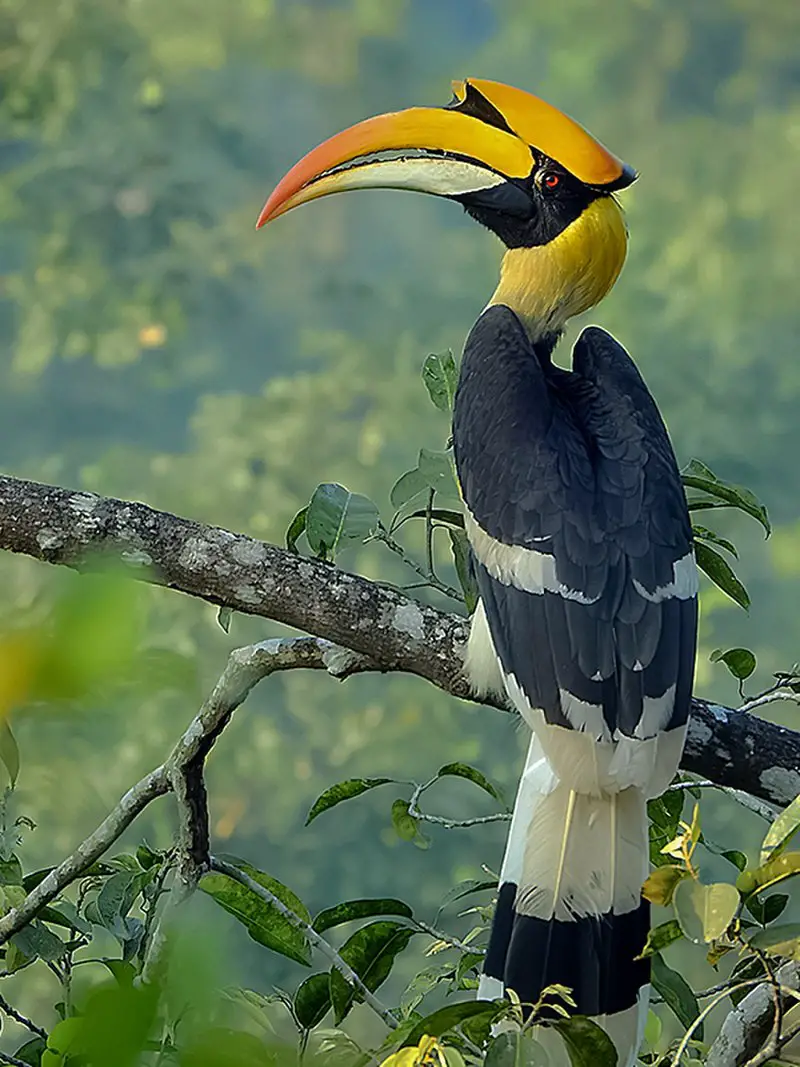
Hornbills are a tropical and subtropical bird species with characteristic long, curved bills. Their English and scientific names both refer to the shape of their bill which resembles that of a cow’s horn.
They have strong beaks for cracking open hard-shelled fruits as well as powerful wings for flying between trees or over great distances in search of food or mates.
Hornbills also feature beautiful plumage ranging from white to black feathers with yellow, brown, red and blue accents on the head, neck and back areas depending on the species.
In addition they often display brightly coloured casques – helmet like structures – atop their upper mandible adding further visual appeal to these majestic birds.
Scientific classification:
| Kingdom | Animalia |
| Phylum | Chordata |
| Class | Aves |
| Order | Bucerotiformes |
| Family | Bucerotidae Rafinesque, 1815 |
41. Collared Kingfisher
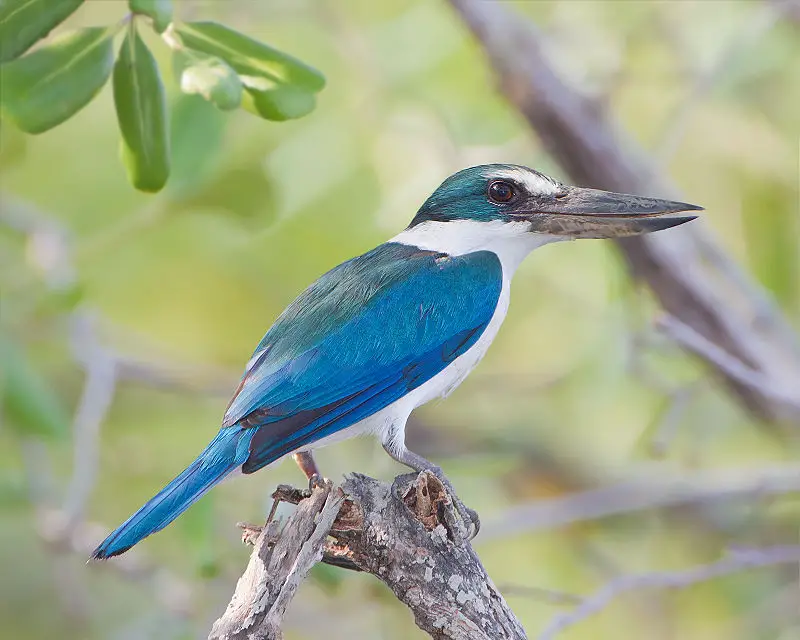
The Collared kingfisher is a medium-sized bird belonging to the Halcyoninae subfamily of tree kingfishers. It has a distinctive white collar and black mask that set it apart from other species in its family.
Its wide range extends from the Red Sea across southern Asia to Polynesia, making it one of the most widespread birds in the region.
The male and female collared kingfisher both have blue wings with dark barring, while juveniles are brownish grey with duller markings.
They feed mainly on fish, but can also be seen consuming crustaceans, reptiles, insects and small mammals when available.
This species nests inside cavities or tunnels near riverbanks or swamps created by their powerful bills; they often dig these themselves if there aren’t any existing ones nearby.
Despite being abundant throughout much of its range, this beautiful bird’s population numbers appear to be declining due to habitat destruction caused by human activity such as deforestation and development projects along riversides which provide important nesting sites for them.
Scientific classification:
| Kingdom | Animalia |
| Phylum | Chordata |
| Class | Aves |
| Order | Coraciiformes |
| Family | Alcedinidae |
| Subfamily | Halcyoninae |
| Genus | Todiramphus |
| Species | T. chloris |
42. Grey-Headed Lapwing
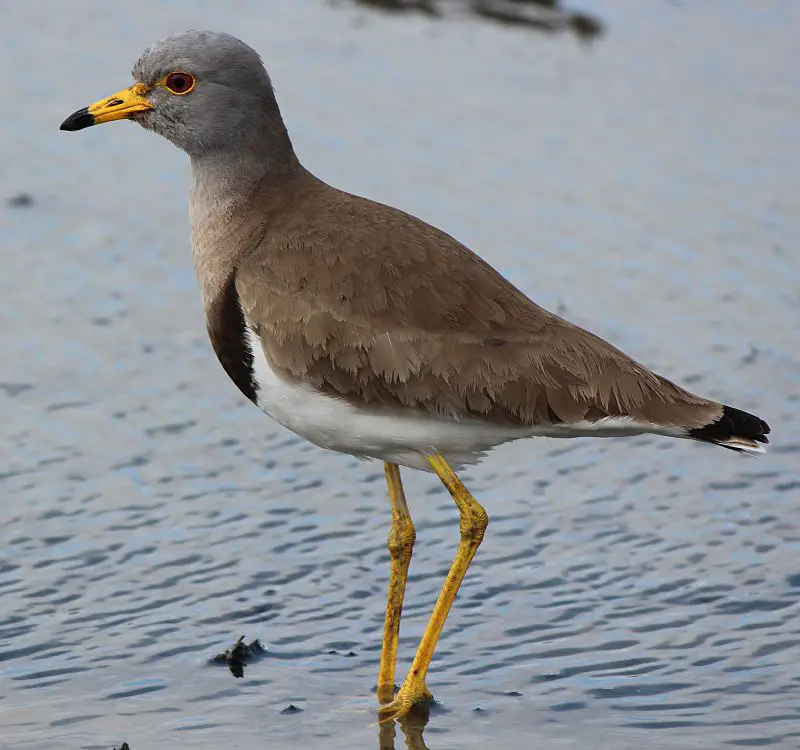
The Grey-headed Lapwing is a bird native to northeast China and Japan. During the winter season, they migrate to northern Southeast Asia from India all the way down to Cambodia.
The Japanese population has been known to spend some of their time in southern Honshū during this period as well.
It’s also classed as a vagrant species in several other countries such Russia, Philippines, Indonesia, Australia and Sri Lanka too.
This lovely little lapwing has grey feathers on its head along with white around its face and neck area which makes it easy for people to identify them if spotted out in nature.
They feed mainly off insects but have occasionally been seen eating plants or small seeds now and then too.
Scientific classification:
| Kingdom | Animalia |
| Phylum | Chordata |
| Class | Aves |
| Order | Charadriiformes |
| Family | Charadriidae |
| Genus | Vanellus |
| Species | V. cinereus |
Also Featured In: Flight Birds You Should Know, Common Birds that Live in Odisha
43. Javan Myna
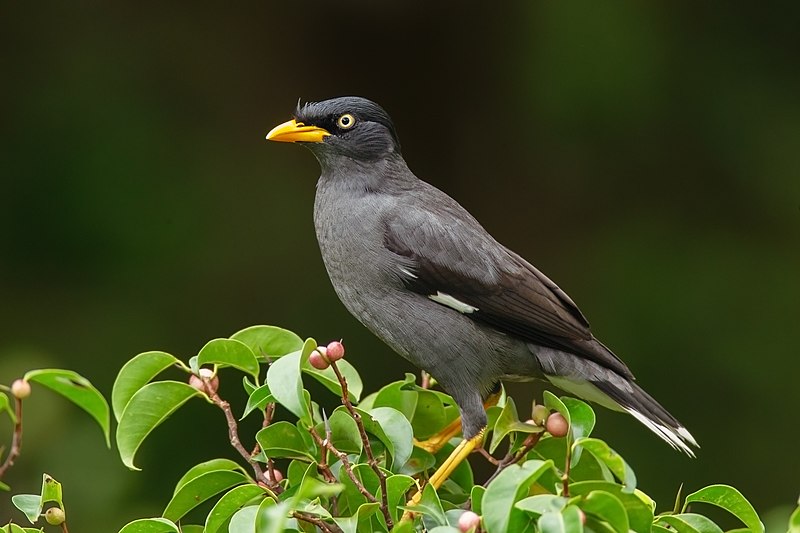
The Javan myna is a species of starling that is native to Bali and Java. It has distinctive white feathers around its vent area, giving it the common name “white-vented myna”.
This beautiful bird has even been introduced to other Asian countries as well as Puerto Rico.
The International Ornithologists’ Union sometimes categorises the Javan Myna with either the great or jungle mynas due to similar traits they share.
These birds are social creatures who live in flocks and feed on insects, fruit, nectar and grain crops.
They have an unmistakable loud call which can be heard from long distances away – adding some character into their natural environment.
Scientific classification:
| Kingdom | Animalia |
| Phylum | Chordata |
| Class | Aves |
| Order | Passeriformes |
| Family | Sturnidae |
| Genus | Acridotheres |
| Species | A. javanicus |
44. Masked Finfoot
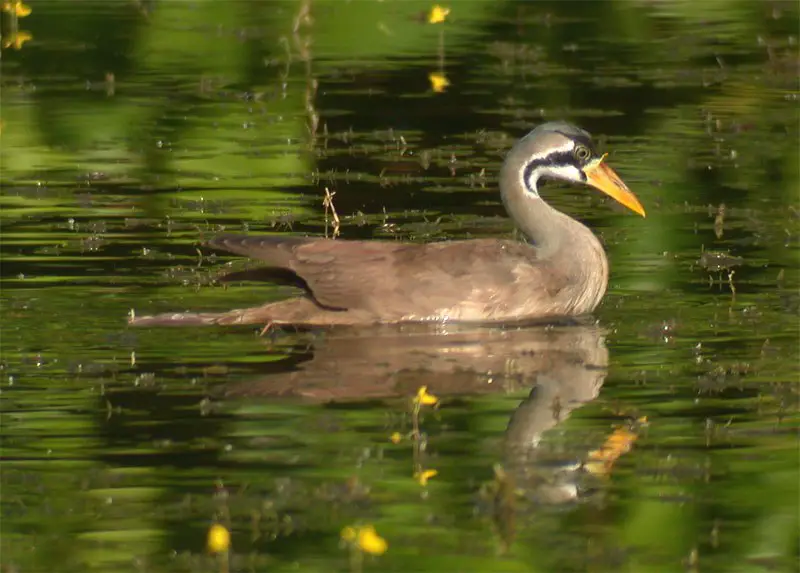
The Masked Finfoot is an endangered bird native to the fresh and brackish wetlands of Eastern India, Indochina, Malaysia and Indonesia.
It belongs to a family whose relationship with other birds remains largely unknown.
This aquatic species has distinct black-and-white plumage that covers its head like a mask while its back and wings are dark green in color.
Its striking red eyes stand out against this otherwise monotone appearance.
The masked finfoot can stay underwater for long periods due to their laterally compressed bodies which help them maneuver through water quickly and efficiently.
They feed mainly on fish but also consume frogs, crustaceans, mollusks, insects and even some plant material from time to time providing valuable ecosystem services such as controlling insect populations near riverside habitats
Scientific classification:
| Kingdom | Animalia |
| Phylum | Chordata |
| Class | Aves |
| Order | Gruiformes |
| Family | Heliornithidae |
| Genus | Heliopais Sharpe, 1893 |
| Species | H. personatus |
45. Common Iora
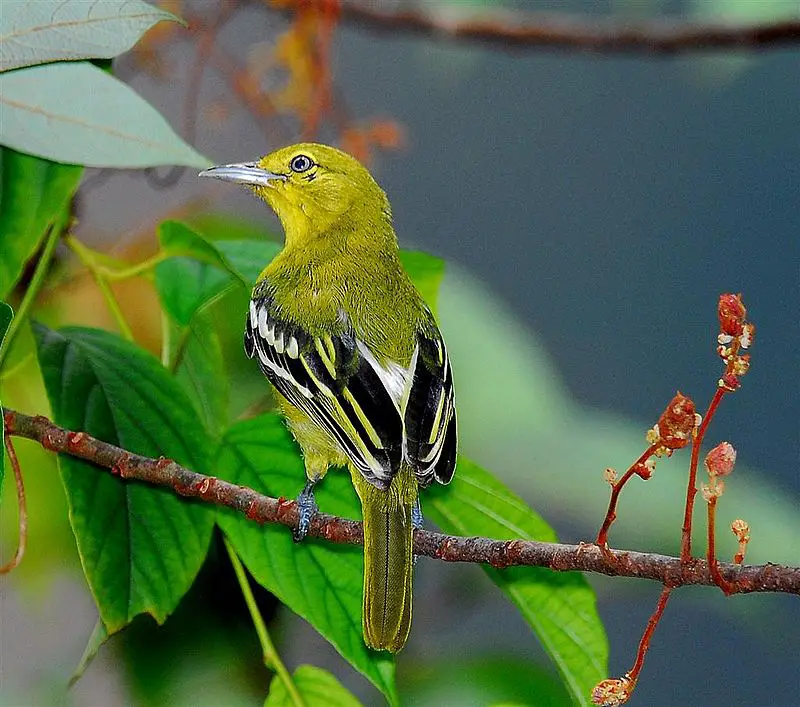
The Common Iora is a bright, small songbird that can be found in the tropical regions of India and Southeast Asia. It has distinctive loud whistles which help to identify it among other passerines.
Its plumage varies depending on where it lives, with some populations having different subspecies-specific colours.
During breeding season males display their feathers by fluffing them up and singing loudly to attract potential mates; females are mostly drabber coloured than the males but still have striking features such as yellow or green wings and tail feathers.
The common iora feeds mainly on insects, using its long bill bent at an angle near its tip to probe for food inside trees’ bark crevices or even into flowers while hovering mid-air.
This bird is usually seen in scrublands and forests but can also sometimes be spotted around urban areas too like parks or gardens
Scientific classification:
| Kingdom | Animalia |
| Phylum | Chordata |
| Class | Aves |
| Order | Passeriformes |
| Family | Aegithinidae |
| Genus | Aegithina |
| Species | A. tiphia |
46. Yellow-Vented Bulbul
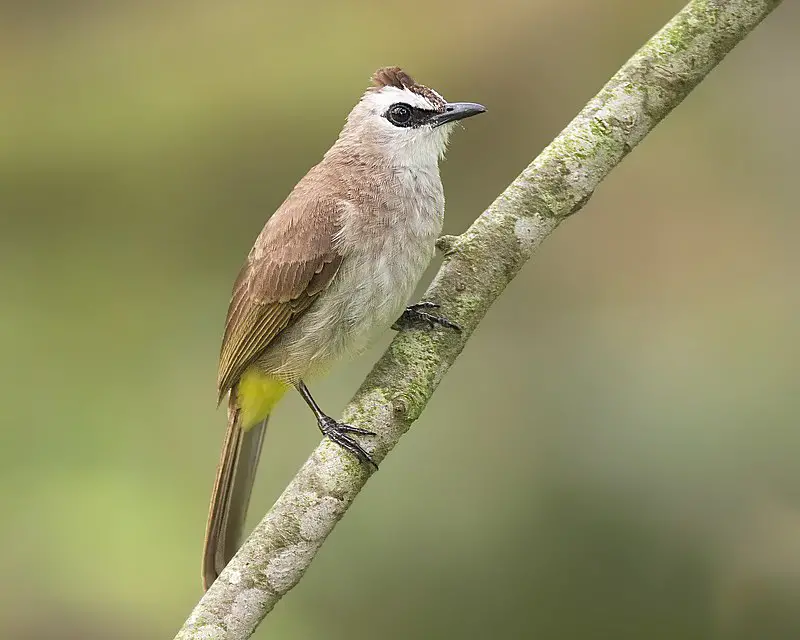
The Yellow-vented Bulbul is a stunning passerine bird from southeastern Asia, with its bright yellow and black plumage. It breeds in open habitats such as cultivated areas, but rarely enters deep forests.
They tend to be nomadic, wandering around and searching for food sources. During the breeding season they form pairs and build their nests at least two metres above ground level in trees or shrubs.
The female lays 2–4 eggs which are incubated by both parents over 13–14 days before hatching into chicks that fledge after 16–17 days of nestling stage..
These birds feed mainly on fruits or berries found in gardens or fields; insects like caterpillars may also make up part of their diet.
As beautiful as it looks, this species has a loud call which can become quite irritating if heard frequently.
Scientific classification:
| Kingdom | Animalia |
| Phylum | Chordata |
| Class | Aves |
| Order | Passeriformes |
| Family | Pycnonotidae |
| Genus | Pycnonotus |
| Species | P. goiavier |
47. Orange-Breasted Green Pigeon
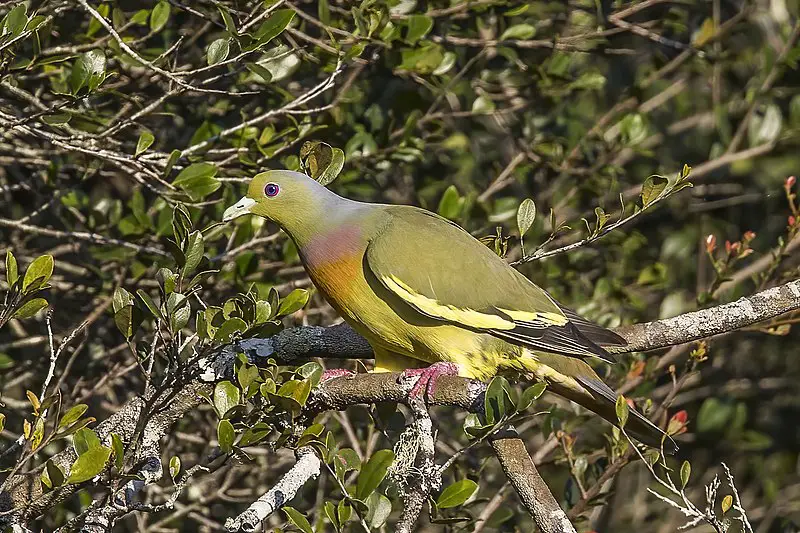
The Orange-breasted green pigeon is a small bird found across tropical Asia, mainly in the Indian Subcontinent and Southeast Asia.
Generally seen in pairs or small flocks, these birds are known for their quiet demeanor while foraging on trees.
They have blue-grey napes with yellowish green crowns, orange breast feathers along with grey wings and tails.
These pigeons predominantly feed on ripe fruits but also consume nuts and seeds to supplement their diet occasionally.
Due to habitat destruction caused by human activities such as logging of forests, this species has been classified as Near Threatened according to IUCN Red List Criteria from 2006 onwards.
Scientific classification:
| Kingdom | Animalia |
| Phylum | Chordata |
| Class | Aves |
| Order | Columbiformes |
| Family | Columbidae |
| Genus | Treron |
| Species | T. bicinctus |
48. Blue-Tailed Bee-Eater
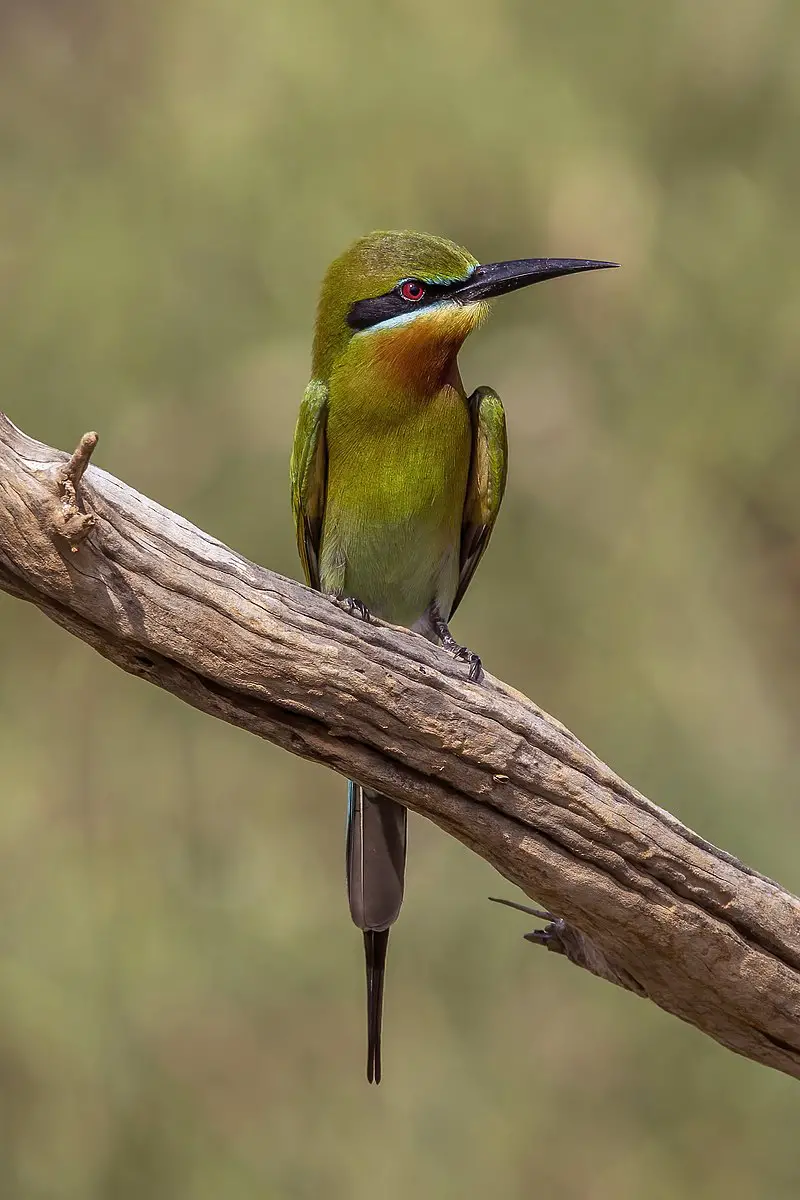
The Blue-tailed Bee-eater is a stunning bird found in South and Southeast Asia. This vibrant species has an iridescent blue tail, green back, yellow chest and white throat that stands out against the bright sky.
It feeds mainly on bees, wasps and other flying insects which it catches using its sharp beak while swooping through the air with remarkable agility.
The bee-eater typically nests by tunneling into loamy sand banks near rivers or streams to create burrows for their eggs.
During migration season they are often seen in large flocks soaring gracefully across the landscape seeking food sources before settling down in colonies during breeding season.
With its beautiful colours and graceful flight this impressive avian beauty captivates anyone lucky enough to see it up close.
Scientific classification:
| Kingdom | Animalia |
| Phylum | Chordata |
| Class | Aves |
| Order | Coraciiformes |
| Family | Meropidae |
| Genus | Merops |
| Species | M. philippinus |
49. Black-Thighed Falconet
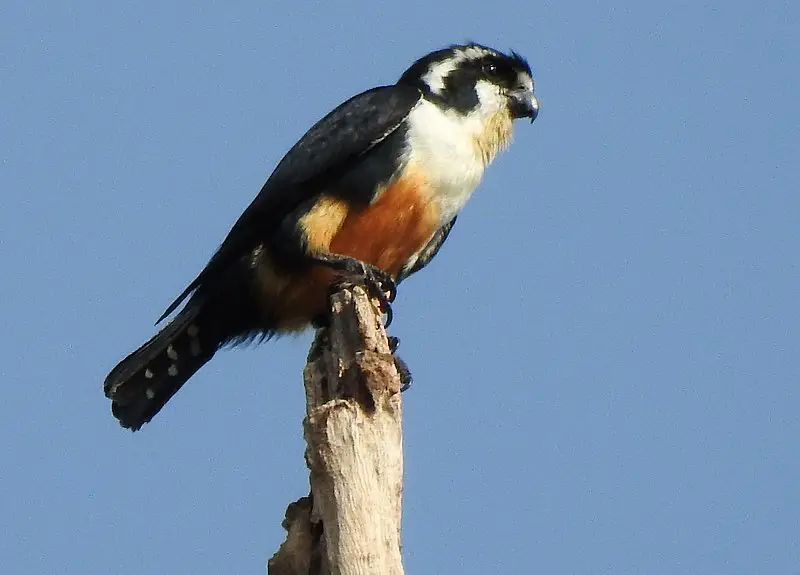
The Black-thighed Falconet is one of the smallest birds of prey in existence. It typically measures between 14–16 centimetres long, with a wingspan of 27–32 cm – about the size of a sparrow.
This species can be found in Brunei Darussalam, Myanmar, Thailand, Malaysia, Singapore and Indonesia.
Thomas Horsfield described it as having striking black legs which contrast against its brown upperparts and white underbelly.
Its tail has alternating bands which helps to distinguish it from other similar looking bird species.
The diet for this raptor consists mostly on flying insects such as dragonflies or grasshoppers but they have also been known to eat small reptiles or amphibians when available.
Scientific classification:
| Kingdom | Animalia |
| Phylum | Chordata |
| Class | Aves |
| Order | Falconiformes |
| Family | Falconidae |
| Genus | Microhierax |
| Species | M. fringillarius |
50. Blue-Winged Pitta
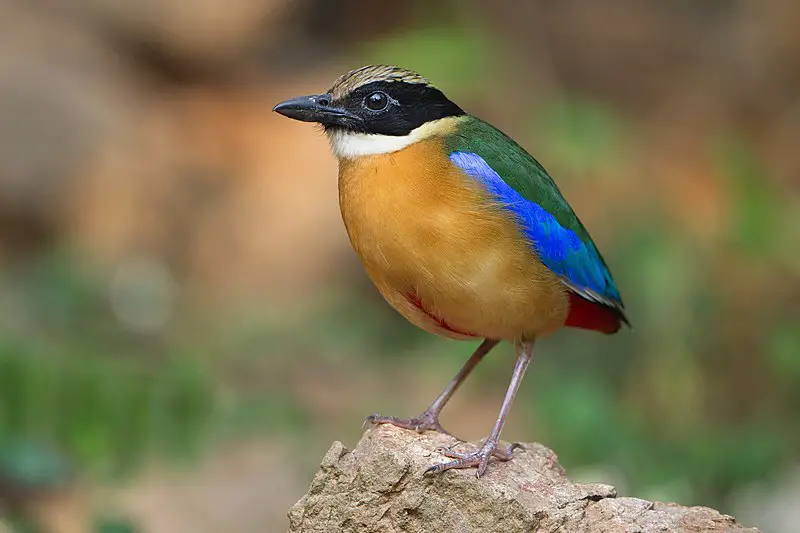
The Blue-winged pitta is a stunningly beautiful passerine bird in the family Pittidae. It has an unmistakable appearance, with its black head and white collar contrasting against its greenish upper parts and blue wings.
Its buff underparts blend into a reddish vent area that adds to the vividness of this species.
This colourful beauty forms part of a larger group known as superspecies which includes three other pittas; Indian, fairy and mangrove varieties respectively.
They can be found in tropical forests across South East Asia where they feed on insects amongst lush foliage or along waterways.
Despite their striking colouration these birds are cryptically coloured making them difficult to spot by predators such as snakes, lizards or cats.
Scientific classification:
| Kingdom | Animalia |
| Phylum | Chordata |
| Class | Aves |
| Order | Passeriformes |
| Family | Pittidae |
| Genus | Pitta |
| Species | P. moluccensis |